Exploring Photovoltaics
Student Guide

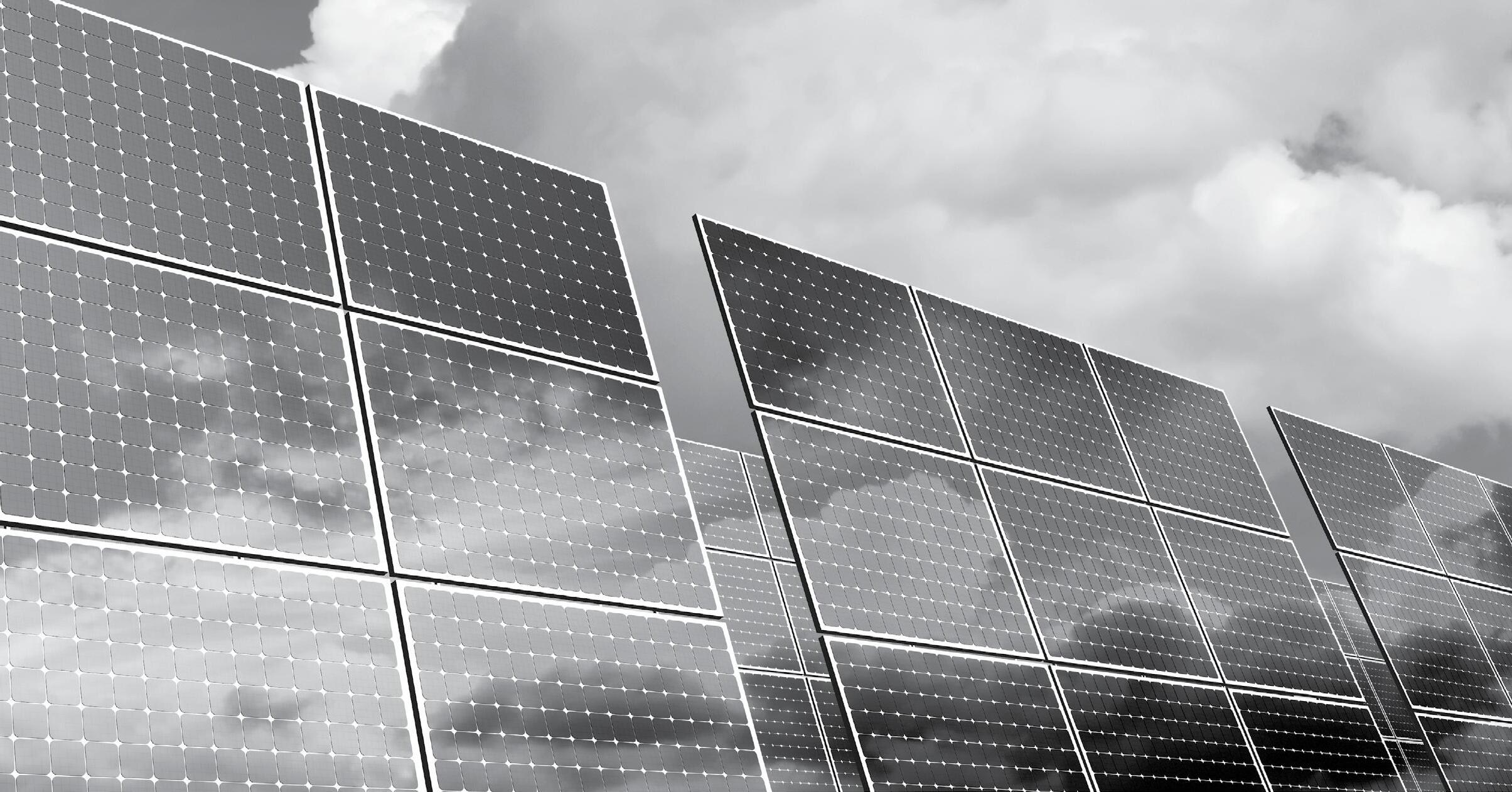



We all use the word energy daily. We have energy drinks, we pay our energy bills, and politicians discuss energy policy almost daily. However, what energy actually is can be a difficult concept to explain precisely. Our bodies and objects all around us are using energy all the time. Energy allows us to do work, and to affect change. It provides the ability to do what we need to do, whether we can visibly see what is happening or on a microscopic level. Energy exists in two basic forms. Stored energy to use later is called potential energy, while energy in motion is called kinetic energy. Each of these two, broad categories can be broken down further into nine different forms of energy.
One type of potential energy is gravitational potential energy (GPE), which is energy stored by position. A child at the top of a slide or water behind a dam both have gravitational energy. Elastic energy is potential energy that is stored by applying a force. When you wind up a toy car, you are storing energy in the spring inside of it. If you pull back on a rubber band, you are storing elastic energy in it. Nuclear energy is the potential energy within the nucleus of atoms. Very small changes in the nucleus of an atom can release tremendous amounts of energy. The most commonly used form of potential energy is chemical energy. It is the energy in the bonds between atoms of all the substances in the world. The food you eat, the fuel in the car you drive, the wood your campfire burns are all examples of chemical energy.
Kinetic energy – energy in motion - can be broken down into five forms. When large-scale things are moving, they have motion or mechanical energy. A child on a bike, water moving through a stream, and the wind all have motion energy. Thermal energy is the energy that allows atoms and molecules to move around. The more thermal energy in a substance, the faster the molecules move, and the higher its temperature. Sound energy is a form of energy that we often overlook – because a sound is a vibration, it is an energy form. Radiant energy is energy that moves through space in transverse waves. Sunlight and radio waves are examples of radiant energy, as are microwaves and x-rays. Electrical energy is the energy of moving electrons. Electricity is the most common example of electrical energy, but small static electricity jolts and lightning strikes are also examples of electrical energy.
Conservation of energy is not just saving energy. The Law of Conservation of Energy says that energy is neither created nor destroyed. When we use energy, it doesn’t disappear. We simply change it from one form of energy into another. A car engine burns gasoline, converting the chemical energy in gasoline into motion energy. Solar cells change radiant energy into electrical energy. Energy changes form, but the total amount of energy in the universe stays the same.
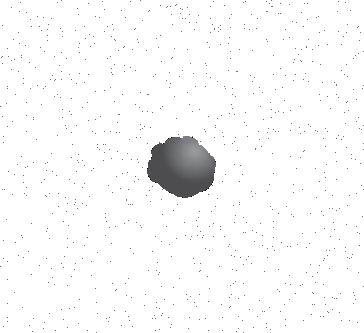


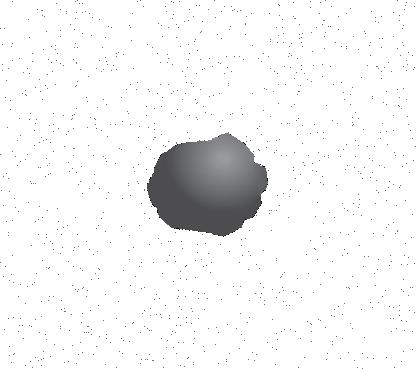
Energy efficiency is the amount of useful energy you get from a system compared to the energy input. A perfect, energy-efficient machine would change all the energy put in it into useful work— an impossible dream. Converting one form of energy into another form always involves a loss of usable energy, often as waste heat.
Most energy transformations are not very efficient. The human body is a good example. Your body is like a machine, and the fuel for your machine is food. Food gives you the energy to move, breathe, and think. Your body is very inefficient at converting food into useful work. Most energy in your body is released as wasted heat.
We use many energy sources to meet our needs. All of them have advantages and disadvantages—limitation or reliability of supply, and economic, environmental, or societal impacts. Energy sources are usually classified into two groups—renewable and nonrenewable
In the United States, most of our energy comes from nonrenewable energy sources. Coal, natural gas, propane, petroleum, and uranium are nonrenewable energy sources. They are used to generate electricity, heat homes, move vehicles, and manufacture all kinds of products from candy bars to computers. They are called nonrenewable because their supplies are limited, and they cannot be replenished in a short period of time.
Petroleum, for example, was formed hundreds of millions of years ago, before dinosaurs lived, from the remains of ancient sea plants and animals. We could run out of economically recoverable nonrenewable resources someday.
Renewable energy sources include biomass, geothermal, hydropower, solar, and wind. They are called renewable because they are replenished in a short time, almost as quickly as they are used. Day after day the sun shines, the wind blows, and the rivers flow. We use renewable energy sources mainly to make electricity.
Electricity is neither a renewable or nonrenewable energy source. Electricity is considered a secondary source of energy because it is created or generated using other sources of energy. In the United States, nine of the ten energy sources are regularly used to generate electricity; the only source that is not commonly used for electricity generation is propane. Natural gas is the leading source for electricity, followed by uranium and coal. Wind and hydropower are the leading renewable energy sources for electricity generation.
The most common way to generate electricity is by using thermal energy to boil water into pressurized steam that can turn a turbine. Turbines change linear motion into rotational motion; in this case, the linear movement of the steam is changed to a rotation to turn a generator. The generator houses large magnets and coils of copper wire. The turbine blades spin the generator, moving either the coils of wire or the magnets relative to the other.
This produces an electric current. Wind and hydropower use a flowing fluid, air or water respectively, to turn the turbine. Because no thermal energy is lost, wind and water are more efficient sources of energy for generating electricity.
Data: Energy Information Administration

Solar energy is radiant energy from the sun. It is vital to us because it provides the world—directly or indirectly—with almost all of its energy. In addition to providing the energy that sustains the world, solar energy is stored in fossil fuels and biomass, and is responsible for powering the water cycle and producing wind.
Every day the sun radiates, or sends out, an enormous amount of energy. The sun radiates more energy each day than the world uses in one year. Solar energy comes from within the sun itself. Like other stars, the sun is a big ball of gases—mostly hydrogen and helium. The hydrogen atoms in the sun’s core combine to form helium and radiant energy in a process called nuclear fusion
During nuclear fusion, the sun’s extremely high pressure and temperature cause nuclei to separate from their electrons. At this extremely energized state, the nuclei are able to fuse, or combine. Hydrogen nuclei fuse to become one helium atom of a higher atomic number and greater mass, and one neutron remains free. This new helium atom, however, contains less mass than the combined masses of the hydrogen isotopes that fused. This transmutation of matter results in some mass being lost. The lost matter is emitted into space as radiant energy. The process of fusion occurs most commonly with lighter elements like hydrogen, but can also occur with heavier nuclei, until iron (Fe) is formed. Because iron is the lowest energy nucleus, it will neither fuse with other elements, nor can it be fissioned (split) into smaller nuclei.
Scientists theorize that the time for the energy in the sun’s core to make its way to the solar surface takes on average, 200,000 years. The nuclear fusion process in the sun’s core produces, among other things, gamma rays. These gamma rays are constantly absorbed and re-emitted as they move through the sun, essentially bouncing in random directions. By the time this “random walk” takes them to the sun’s surface they have been transformed into visible light. This light escapes from the photosphere, the visible surface of the sun, and arrives at Earth about eight minutes later. The solar energy travels to the Earth at a speed of 3.0 x 108 meters per second (186,000 miles per second), the speed of light. Heat energy is not transmitted from the sun because the space between the sun and Earth is mostly a vacuum. Rather, radiant energy transforms into thermal energy when it strikes the molecules in the atmosphere or on the surface of the Earth.
Only a small portion of the energy radiated by the sun into space strikes the Earth—one part in two billion. Yet, this amount of energy is enormous. It was mentioned before that the sun provides more energy in a day than the world uses in a year. The sun also provides more energy in an hour than the United States uses in a year!
Where does all this energy go? About 30 percent of the sun’s energy that hits the Earth is reflected back into space. Another 25 percent powers the water cycle; it evaporates water that is then drawn into the atmosphere, turns into clouds, condenses, and falls back to Earth as precipitation. Plants, the land, and the oceans also absorb a portion of solar energy. The rest is reflected and could be used to supply our energy needs. A surface’s albedo describes how much solar energy it reflects.
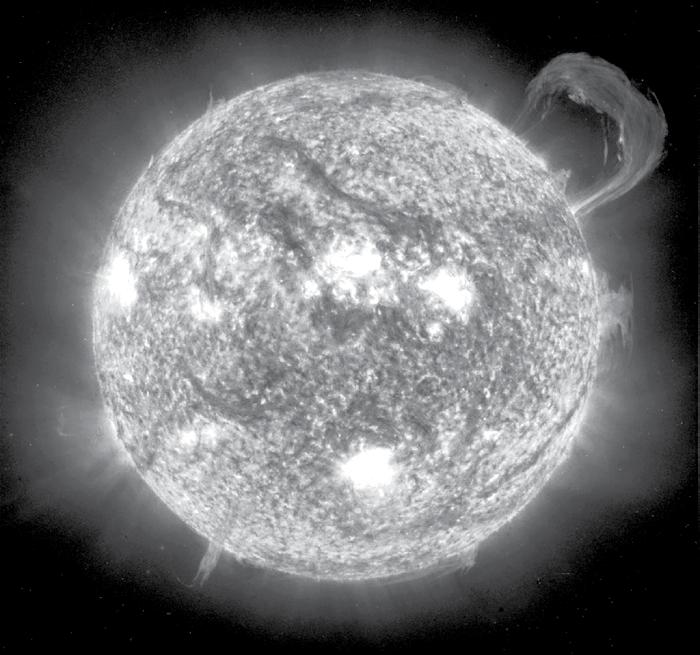
The process of fusion most commonly involves hydrogen isotopes combining to form a helium atom with a transformation of matter. This matter is emitted as radiant energy.




Average reflectivity of solar radiation for various surfaces.
Solar energy is considered a renewable energy source. Renewable sources of energy are resources that are continually replenished by nature, and hence will never run out. Solar power is considered renewable because the nuclear fusion reactions that power the sun are expected to keep generating sunlight for many billions of years.
People have harnessed solar energy for centuries. As early as the 7th century BCE, people used simple magnifying glasses to concentrate the light of the sun into beams so hot they could cause wood to catch fire.
In the 1860s in France, a scientist named Auguste Mouchout used heat from a solar collector to make steam to drive a steam engine. Around the same time in the United States, John Ericsson developed the first realistic application of solar energy using a solar reflector to drive an engine in a steam boiler. With coal becoming widely used, neither of these inventions became part of the mainstream.
Early in the 1900s, scientists and engineers began seriously researching ways to use solar energy. The solar water heater gained popularity during this time in Florida, California, and the Southwest. The industry was in full swing just before World War II. This growth lasted until the mid-1950s, when low-cost, natural gas became the primary fuel for heating homes and water, and solar heating lost popularity.
The public and world governments remained largely indifferent to the possibilities of solar energy until the energy crises of the 1970s. Research efforts in the U.S. and around the world since that time have resulted in tremendous improvements in solar technologies for heating water and buildings and generating electricity. Today, solar energy accounts for under one percent of U.S. energy consumption.
Heating with solar energy is relatively easy—just look at a car parked in the sun with its windows closed. Getting the right amount of heat in a desired location, however, requires more thought and careful design. Capturing sunlight and putting it to work effectively is difficult because the solar energy that reaches the Earth is spread out over a large area. The sun does not deliver that much energy to any one place at any one time.
How much solar energy a place receives depends on several conditions. These include the time of day, the season, the latitude of the area, the topography, and the amount of clouds in the sky.
A solar collector is one way to collect heat from the sun. A closed car on a sunny day is like a solar collector. As the sunlight passes through the car’s glass windows, it is absorbed by the seat covers, walls, and floor of the car. The light that is absorbed changes into heat. The car’s glass windows let light in, but do not let all the heat out. This is also how greenhouses are designed to stay warm year-round. A greenhouse or solar collector:
allows sunlight in through the glass;
absorbs the sunlight and changes it into heat; and
traps most of the heat inside.

On a sunny day, a closed car becomes a solar collec tor. Radiant energy from the sun passes through the window glass, is absorbed by the ca r’s interior, and conver ted into thermal energy, which becomes trapped inside.
Photovoltaic (or PV) systems convert light directly into electricity. The term photo comes from the Greek phos, which means “light.” The term volt is a measure of electricity named for Alessandro Volta (17451827), a pioneer in the development of electricity. Photovoltaics literally means light–electricity.
Commonly known as solar cells, PV cells are already an important part of our lives. The simplest PV systems power many of the small calculators, wrist watches, and outdoor lights we see every day. Larger PV systems generate electricity for factories and warehouses, provide electricity for pumping water, powering communications equipment, and lighting homes and running appliances.
In certain applications and remote settings, such as motorist aid call boxes on highways and pumping water for livestock, PV power is the cheapest form of electricity. Electric utility companies are building and including PV systems into their power supply networks.
French physicist Edmond Becquerel first described the photovoltaic effect in 1839, but it remained a curiosity of science for the next half century. At the age of 19, Becquerel found that certain materials would produce small amounts of electric current when exposed to light. In the 1870s, William Adams and Richard Day showed that light could produce an electric current in selenium. Charles Fritts then invented the first PV cell using selenium and gold leaf in 1883, which converted light to electricity at about one percent efficiency.
The conversion efficiency of a PV cell is the proportion of radiant energy the cell converts into electrical energy, relative to the amount of radiant energy that is available and striking the PV cell. This is very important when discussing PV devices, because improving this efficiency is vital to making PV energy competitive with more traditional sources of energy, such as fossil fuels.
During the second half of the 20th century, PV science was refined and the process more fully developed. Major steps toward commercializing photovoltaics were taken in the 1940s and 1950s, when the Czochralski process was developed for producing highly pure crystalline silicon.
In 1954, scientists at Bell Laboratories depended on the Czochralski process to develop the first crystalline silicon photovoltaic cell, which had a conversion efficiency of four percent.
As a result of technological advances, the cost of PV cells has decreased significantly over the past 25-30 years, as the efficiency has increased. Today’s commercially available PV devices convert 17 to 30 percent of the radiant energy that strikes them into electricity.
In the laboratory, combining exotic materials with specialized cell designs has produced PV cells with conversion efficiencies as high as 50 percent. The current expense of these technologies typically restricts their use to aerospace and industrial applications, where the unit cost of a solar array that powers, for example, a satellite is a minor concern.
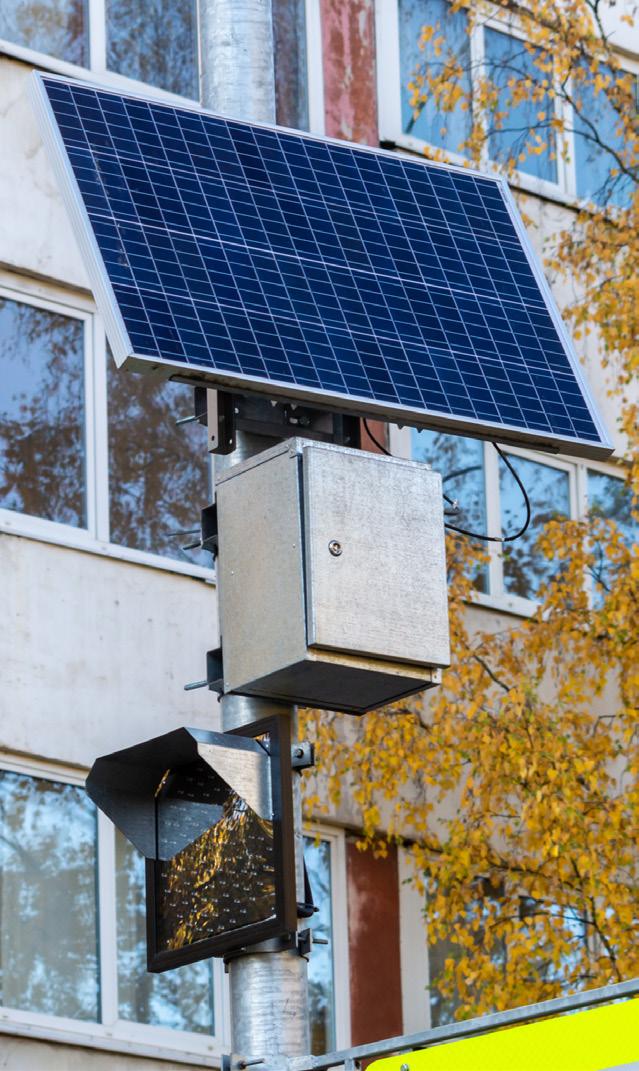
Solar cells provide power to traffic signals and road signs. Attached to the support pole are boxes that store control panels and batteries for operation when the sun is not available.
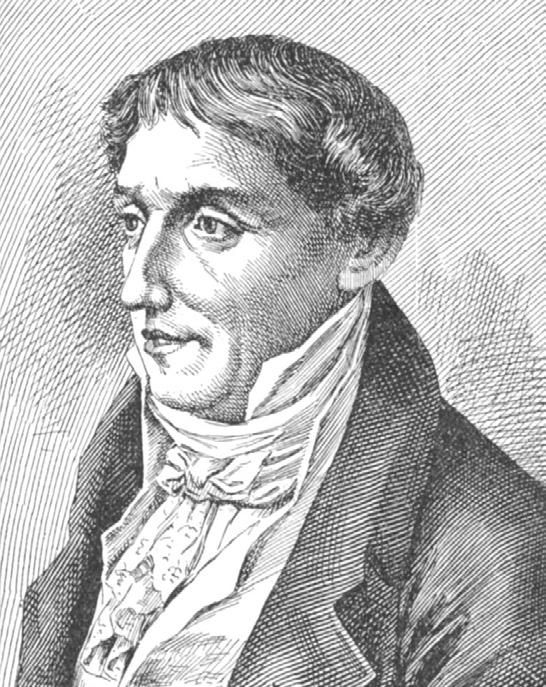


The photovoltaic effect is the basic physical process through which a PV cell converts sunlight directly into electricity. PV technology works any time the sun is shining, but more electricity is produced when the light is more intense and when it is striking the PV modules directly—when the rays of sunlight are perpendicular to the PV modules.
Unlike solar systems for heating water, PV technology does not produce heat to make electricity. Instead, PV cells generate electricity directly from the electrons freed by the interaction of radiant energy with the semiconductor materials in the PV cells.
Sunlight is composed of photons, or bundles of radiant energy. When photons strike a PV cell, they may be reflected, absorbed, or transmitted through the cell.
Only the absorbed photons generate electricity. When the photons are absorbed, the energy of the photons is transferred to electrons in the atoms of the solar cell, which is actually a semiconductor
With their new-found energy, the electrons are able to escape from their normal positions associated with their atoms to become part of the current in an electrical circuit. By leaving their positions, the electrons cause holes to form in the atomic structure of the cell into which other electrons can move.
Special electrical properties of the PV cell—a built-in electric field— provide the voltage needed to drive the current through a circuit and power an external load, such as a light bulb.
The basic building block of PV technology is the photovoltaic cell Different materials are used to produce PV cells, but silicon—the main ingredient in sand—is the most common basic material. Silicon, a common semiconductor material, is relatively cheap because it is widely available and used in other things, such as televisions, radios, and computers. PV cells, however, require very pure silicon, which can be expensive to produce.
The amount of electricity a PV cell produces depends on its size, its conversion efficiency, and the intensity of the light source. Efficiency is a measure of the amount of electricity produced from the sunlight a cell receives. A typical PV cell produces 0.5 volts of electricity. It takes just a few PV cells to produce enough electricity to power a small watch or solar calculator.
The most important parts of a PV cell are the semiconductor layers, where the electric current is created. There are a number of different materials suitable for making these semi-conducting layers, and each has benefits and drawbacks. Unfortunately, there is no one ideal material for all types of cells and applications.
Silicon is used as a semiconductor because it has four valence electrons and does not want to lose or gain electrons. Therefore, the electrons ow across it from the boron side to the phosphorus side without the silicon interfering with the movement.
PV cells come in many shapes and sizes. The most common shapes are circles, rectangles, and squares. The size and the shape of a PV cell, and the number of PV cells required for one PV module, depend on the material of which the PV cell is made.
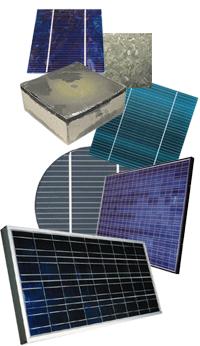
Let’s look more closely at how a PV cell is made and how it produces electricity.
Step 1
A slab (or wafer) of pure silicon is used to make a PV cell. The top of the slab is very thinly diffused with an “n” dopant, such as phosphorous. On the base of the slab, a small amount of a “p” dopant, typically boron, is diffused. The boron side of the slab is 1,000 times thicker than the phosphorous side. Dopants are similar in atomic structure to the primary material. The phosphorous has one more electron in its outer shell than silicon, and the boron has one less. These dopants help create the electric field that motivates the energetic electrons out of the cell created when light strikes the PV cell.
The phosphorous gives the wafer of silicon an excess of free electrons; it has a negative character. This is called the n-type silicon (n = negative). The n-type silicon is not charged—it has an equal number of protons and electrons—but some of the electrons are not held tightly to the atoms. They are free to move to different locations within the layer. This silicon has a negative character, but not a negative charge.
The boron gives the base of the silicon wafer a positive character, which will cause electrons to flow toward it. The base of the silicon is called p-type silicon (p = positive). The p-type silicon has an equal number of protons and electrons; it has a positive character, but not a positive charge.
Step 2
Where the n-type silicon and p-type silicon meet, free electrons from the n-layer flow into the p-layer for a split second, then form a barrier to prevent more electrons from moving between the two sides. This point of contact and barrier is called the p-n junction. When both sides of the silicon slab are doped, there is now a negative charge in the p-type section of the junction and a positive charge in the n-type section of the junction due to movement of the electrons and “holes” at the junction of the two types of materials. This imbalance in electrical charge at the p-n junction produces an electric field between the p-type and n-type.
Step 3
If the PV cell is placed in the sun, photons of light strike the electrons in the p-n junction and energize them, knocking them free of their atoms. These electrons are attracted to the positive charge in the n-type silicon and repelled by the negative charge in the p-type silicon. Most photon-electron collisions actually occur in the silicon base.
Step 4
A conducting wire connects the p-type silicon to an external load such as a light or battery, and then back to the n-type silicon, forming a complete circuit. As the free electrons are pushed into the n-type silicon, they repel each other because they are of like charge. The wire provides a path for the electrons to move away from each other. This flow of electrons is an electric current that can power a load, such as a calculator or other device, as it travels through the circuit from the n-type to the p-type.
In addition to the semi-conducting materials, solar cells consist of a top metallic grid or other electrical contact to collect electrons from the semiconductor and transfer them to the external load, and a back contact layer to complete the electrical circuit.
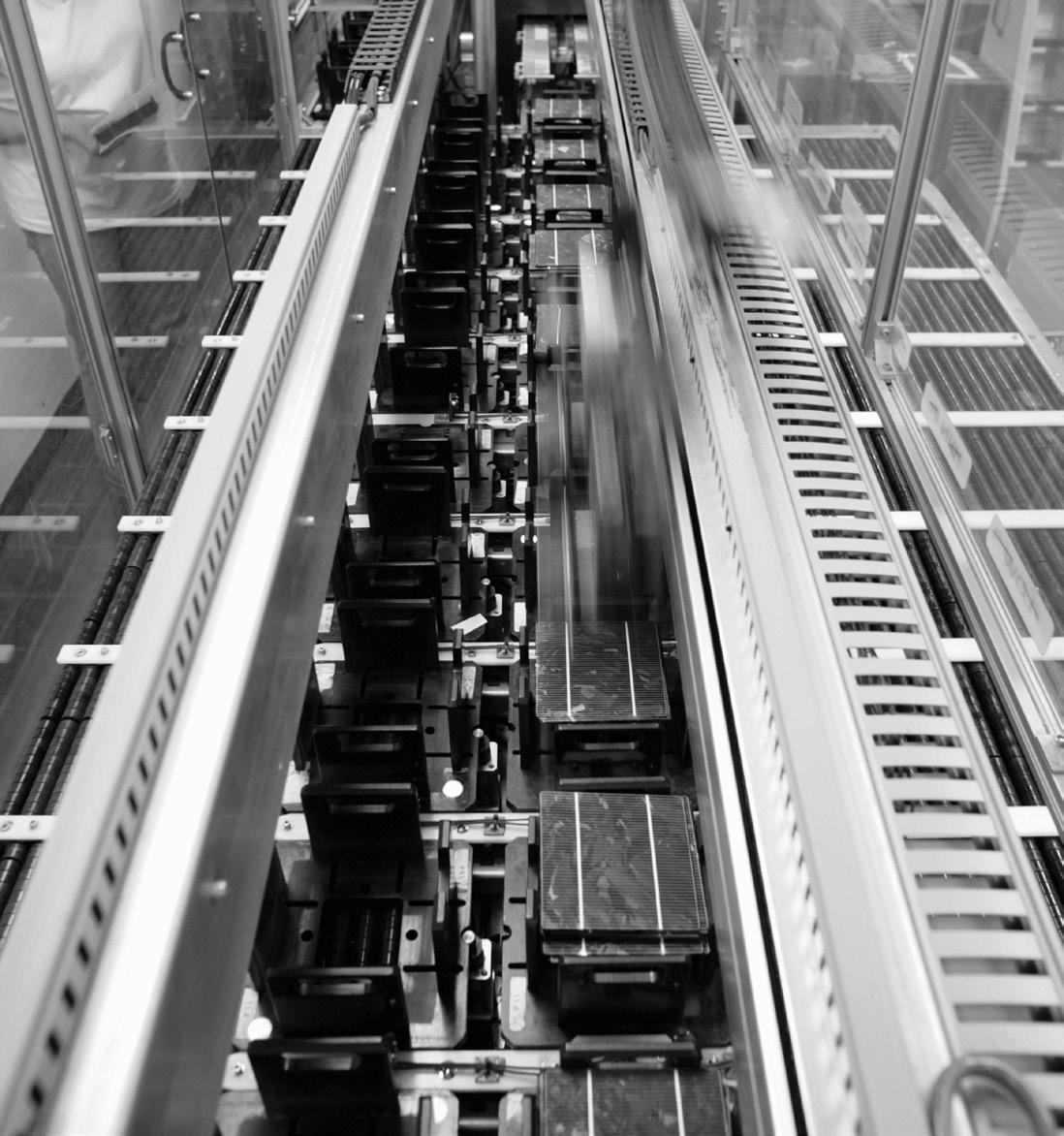
For more power, PV cells are connected together to form larger units called modules. Photovoltaic cells are connected in series and/ or parallel circuits to produce higher voltages, currents, and power levels. A PV module is the smallest PV component sold commercially, and can range in power output from about 10 watts to 300 watts.
A typical PV module consists of PV cells sandwiched between a clear front sheet, usually glass, and a backing sheet, usually glass or a type of tough plastic. This protects them from breakage and from the weather. An aluminum frame can be fitted around the PV module to enable easy affixing to a support structure. Photovoltaic arrays include two or more PV modules assembled as a pre-wired, fieldinstallable unit. A PV array is the complete power-generating unit, consisting of any number of modules and panels.
Although a PV module produces power when exposed to sunlight, a number of other components are required to properly conduct, control, convert, distribute, and store the energy produced by the array. Depending on the type of system, these components may include:
Power Inverter
PV modules, because of their electrical properties, produce direct current rather than alternating current. Direct current (DC) is electric current that flows in a single direction. Many simple devices, such as those that run on batteries, use direct current. Alternating current (AC), in contrast, is electric current that reverses its direction of flow at regular intervals (120 times per second). This is the type of electricity provided by utilities, and the type required to run most modern appliances and electronic devices.
In the simplest systems, DC current produced by PV modules is used directly. In applications where AC current is necessary, an inverter can be added to the system to convert DC to AC current.
Battery System
PV systems cannot store electricity, so batteries or large battery systems are often added. A PV system with a battery is configured by connecting the PV array to an inverter. The inverter is connected to a battery bank and to any load. During daylight hours, the PV array charges the battery bank. The battery bank supplies power to the load whenever it is needed. A device called a charge controller keeps the battery properly charged and prolongs its life by protecting it from being overcharged or completely discharged.
PV systems with batteries can be designed to power DC or AC equipment. Systems operating only DC equipment do not need an inverter, only a charge controller. Utility scale systems can be set up to charge large systems and deploy electricity as needed to the grid.
It is useful to remember that any time conversions are made in a system, there are associated losses. For example, when an inverter is used there is a small loss of power that can be described by the inverter’s conversion efficiency. Likewise, when batteries are used to store power, not only is there additional expense to purchase the batteries and associated equipment, but due to the internal resistance of the batteries there is a small loss of power as the charge is drawn out of the batteries.
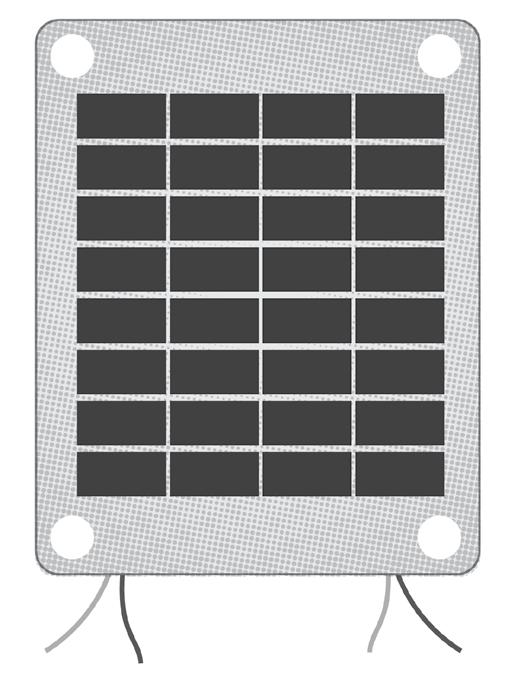


Two types of PV systems are grid-connected systems and standalone systems. The main difference between these systems is that one is connected to the utility grid and the other is not.
Grid-Connected Systems
Grid-connected systems are designed to operate in parallel with, and interconnected with, the national electric utility grid. What is the grid? It is the network of cables through which electricity is transported from power stations to homes, schools, and other places. A grid-connected system is linked to this network of power lines.
The primary component of a grid-connected system is the inverter, or power conditioning unit (PCU). The inverter converts the DC power produced by the PV system into AC power, consistent with the voltage and power quality requirements of the utility grid. This means that it can deliver the electricity it produces into the electricity network and draw it down when needed. While no battery or other storage is needed for solar systems, many large-scale grid-connected systems may employ battery storage to help manage demand.
As its name suggests, this type of PV system is a separate electricity supply system. A stand-alone system is designed to operate independent of the national electric utility grid, and to supply electricity to a single system. Usually a stand-alone system includes one or more batteries to store the electricity.
Historically, PV systems were used only as stand–alone systems in remote areas where there was no other electricity supply. Today, stand-alone systems are used for water pumping, highway lighting, weather stations, homes, and other uses away from power lines.
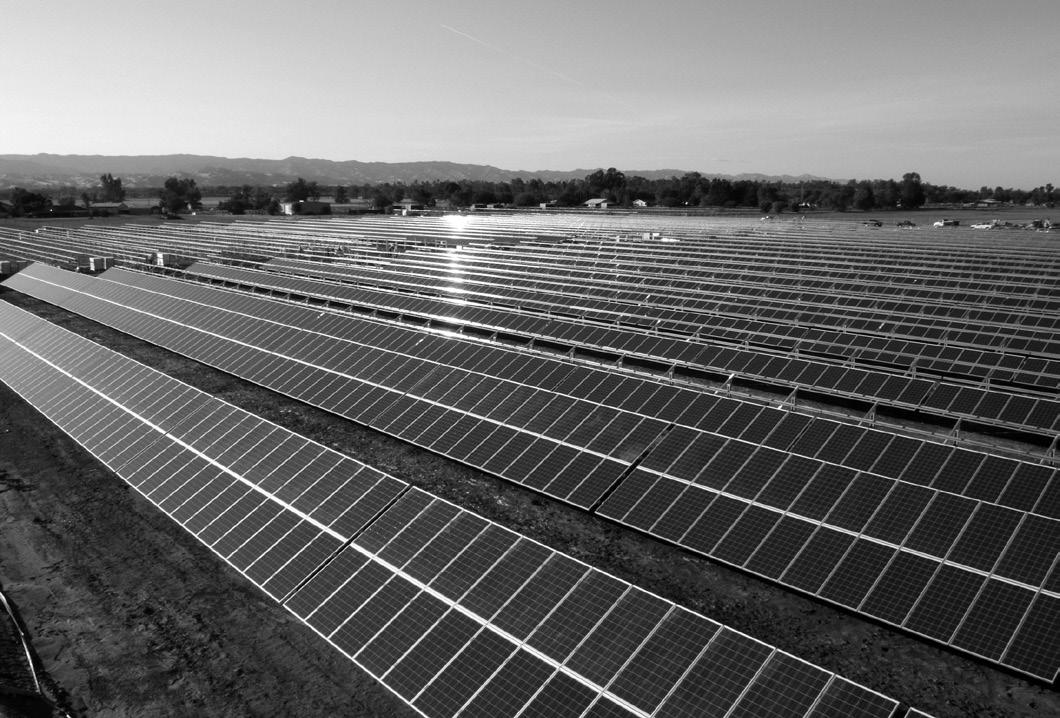
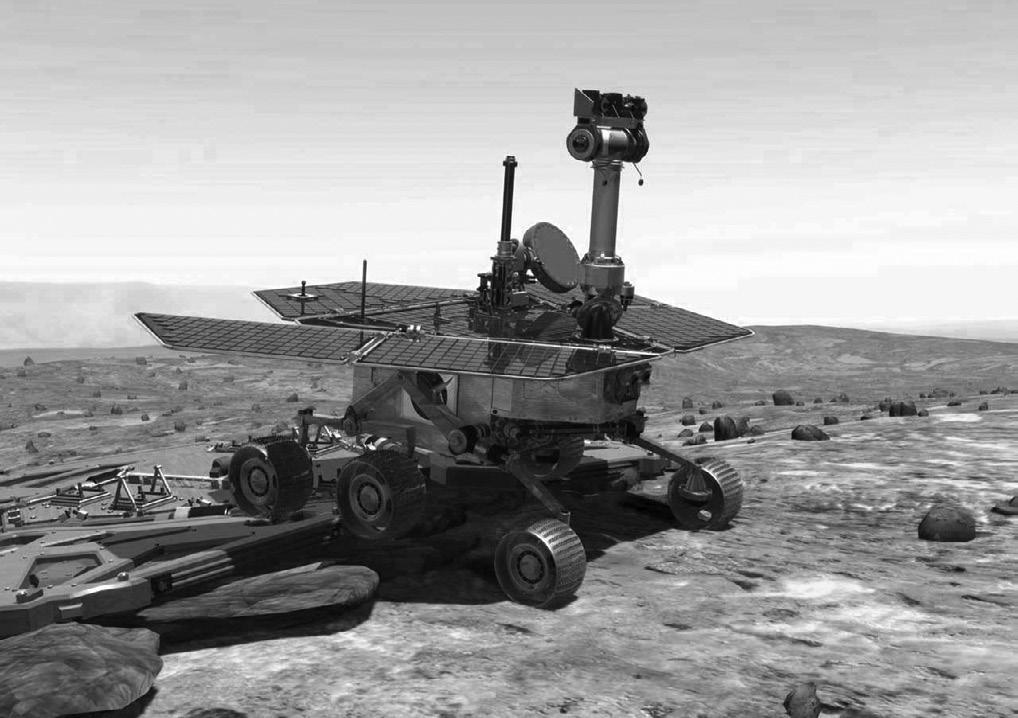
There are three general scales at which photovoltaic systems are generally installed. They are:
Residential
A residential system is designed to offset power usage at an individual residence. While usually unable to provide all power used by the homeowners, the system could help to offset the home’s electricity usage. This type of system might produce enough electricity to power part, or all, of one home’s electricity needs.
Commercial
A commercial system is designed to offset power usage at a business or industrial site. These systems are much larger than residential systems that can produce more power due to the often expansive roof-top space available for their installation. An example would be a grocery store that contracts with a company to place a solar array on their flat roof while simultaneously contracting to buy power from the installer at a fixed rate for many years. This type of system might produce enough electricity to operate all or part of the business or industrial site.
Utility
Utility systems are employed by energy companies to produce baseload or peak load power for sale to consumers. Large areas of land are typically required for their installation. An example would be a large PV array that is employed to produce power at peak usage times in the summer months when air conditioning accounts for a large part of the electrical usage. The array produces the most power when the sun is at its peak and causing consumers to turn down their thermostats—requiring the extra electricity produced by the array.
Like solar cells, solar thermal systems use solar energy to make electricity. Concentrated solar power (CSP) technologies focus heat in one area to produce the high temperatures required to make electricity. Since the solar radiation that reaches the Earth is so spread out and diluted, it must be concentrated to produce the high temperatures required to generate electricity. There are several types of technologies that use mirrors or other reflecting surfaces to concentrate the sun’s energy up to 2,000 times its normal intensity.
Parabolic troughs use long reflecting troughs that focus the sunlight onto a pipe located at the focal line. A fluid circulating inside the pipe collects the energy and transfers it to a heat exchanger, which produces steam to drive a turbine. The U.S. has several large parabolic trough systems located in California and Arizona. However, the world’s largest, a 600 megawatt trough system, is located in Dubai. The solar park which houses the trough also includes a power tower system that will be the tallest in the world.
Solar power towers use a large field of rotating mirrors to track the sun and focus the sunlight onto a thermal receiver on top of a tall tower. The fluid in the receiver collects the heat and either uses it to generate electricity or stores it for later use. The Ivanpah Solar Electric Generating System, located in California, uses three power towers and 170,000 heliostats to generate electricity for over 140,000 homes. It is the largest CSP facility of any kind in the entire world and can generate 392 megawatts. Both Dubai and Morocco, however, are constructing facilities that will surpass this facility in generating capacity once completed.
Dish/engine systems are like satellite dishes that concentrate sunlight rather than signals, with a heat engine located at the focal point to generate electricity. These generators are small mobile units that can be operated individually or in clusters, in urban and remote locations.
Concentrated solar power technologies require a continuous supply of strong sunlight, like that found in hot, dry regions such as deserts. Developing countries with increasing electricity demand will probably be the first to use CSP technologies on a large scale.

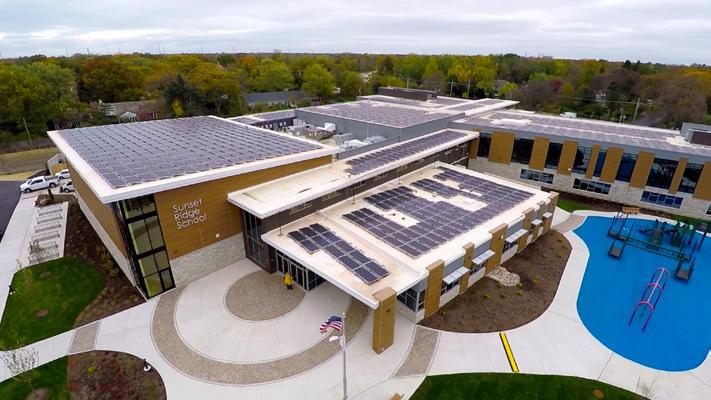

Today there are many new PV technologies either on the market, in the pipeline, or in the research phase. These technologies will have a direct effect on how much of our energy we derive from solar power in the future. Look for technologies that will make things less expensive or serve multiple purposes as they are applied to new designs.
Ribbon Silicon
Thin crystalline silicon sheets are drawn out of molten silicon rather than being sawed from an ingot. This method is less expensive and less wasteful to produce silicon. However, the finished product is usually a lower quality material. In some cases, they will have cells of a higher conversion efficiency.
Thin-Film Technologies
This new class of materials allows the production of PV cells that are smaller and more flexible than the delicate silicon wafer technology that has dominated PV cell production in the past. These materials are not crystalline, but amorphous, in structure. This type of PV cell can actually be applied to a variety of materials to make any number of materials that you might use for another purpose—such as glazing for a window, or shingles for a roof. Imagine windows that produce electricity! Materials used for dual purposes (building material and PV cell) are called Building Integrated Photovoltaics (BIPV).
CdTe: Cadmium Telluride
This thin-film technology has higher solar spectrum absorption and lower costs to manufacture. It can have a conversion efficiency of up to 19%. There are concerns about the toxicity and scarcity of chemicals necessary for its production.
CIGS: Copper Indium Gallium Diselenide
The gallium is added to these thin-film cells to increase the energy absorption of the cells, which increases efficiency. This technology, although slightly more complicated, has a similar conversion efficiency of 20%.
Earth Abundant Materials
Manufacturing PV cells from abundant, low cost resources is a research priority. One of the promising technologies is sulfoselenide or CZTS. The drawback to CZTS is a lower efficiency than other PV cells.
Thin-film materials are much cheaper to produce and are lightweight. They are very versatile in how they can be applied to many structural materials. They can also be less efficient than current silicon crystal PV cells. However, what they lack in efficiency may be overcome by their flexibility of application and low cost.
Multijunction Technologies
This category actually combines multiple layers of materials that are designed to absorb different wavelengths of solar energy— improving the efficiency of the cell by combining the output of the various layers. Multijunction cells are a high-cost PV technology, but can reach efficiencies of over 50 percent.
This organic-inorganic hybrid technology shows promise to be a very low cost technology. Using a small-molecule dye that absorbs photons, an acceping material such as zinc ozide, and an electrolyte, this technology is easy to manufacture from abundant materials. Research continues to improve durability and efficiency.

In 2014, researchers at Michigan State University developed a material that absorbs nonvisible UV and infrared light, and emits and directs the energy as a different wavelength of near-infrared light. At the edge of the transparent material are thin photovoltaic cells, which use the near-infrared light to generate electricity. Currently the conversion efficiency is around one percent, but developers hope to reach seven percent. This technology is still in the research and development stage, but it could lead to windows and cell phone screens that generate electricity from sunlight.
A perovskite is a substance with the same crystalline structure as calcium titanium oxide, with the generalized formula ABX3. A and B represent positive ions, and X represents a negative ion. Perovskites are optically active and because they can be composed of a wide variety of elements, they can be fine-tuned to interact with specific wavelengths of light. Researchers have achieved conversion efficiencies of up to 25 percent in pure perovskite photovoltaics, and combined with silicon the maximum efficiency is almost 30 percent.
PEROVSKITE STRUCTURE

Imagine you are designing a residential, multi-family building. You want it to look good, but you also want it to be energy efficient. How can you keep the energy use of several residences under control, use renewable energy, and maintain a certain aesthetic? Organic photovoltaics might be the answer in the near future. OPV solar cells are polymer-based and are thin, lightweight, and flexible. Furthermore, they can be manufactured in different colors, so adding them to a building, or incorporating into a newly constructed building, does not necessarily sacrifice any design principles. Instead of a single layer doped with two dopants, as is the case in siliconbased photovoltaics, OPV uses two layers; one is an electron donor layer, and the other is an electron acceptor layer. Solar cells made using OPV currently have conversion efficiencies of around 13 percent, but that number is expected to improve in this rapidlyexpanding area of research.

Benefits
Photovoltaic systems offer many advantages:
they are safe, clean, and quiet to operate;
they are highly reliable;
they require virtually no maintenance;
they are cost-effective in remote areas and for some residential and commercial applications;
they are flexible and can be expanded to meet increasing electrical needs for homes and businesses;
they can provide independence from the grid or back-up during outages; and
the fuel is renewable, domestically available, and free.
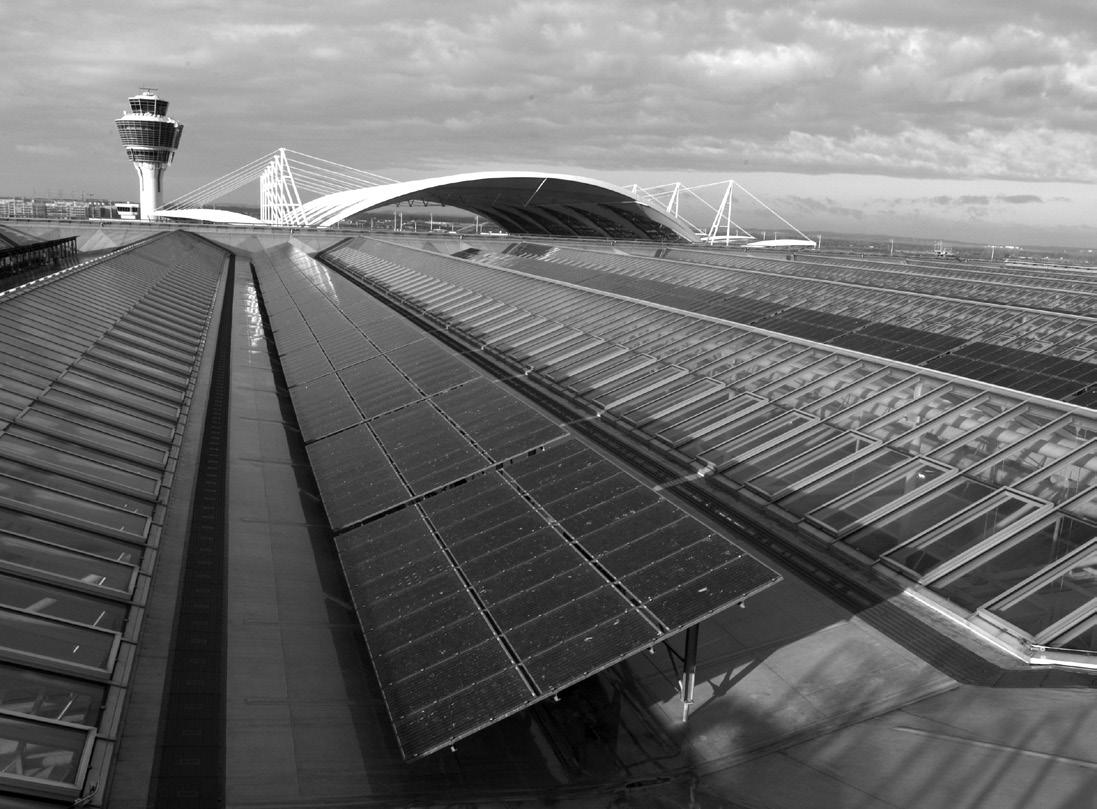
Limitations
There are also some practical limitations to PV systems:
PV systems cannot operate all the time;
PV systems are not well suited for energy-intensive uses such as heating;
grid-connected systems are becoming more economical, but can be expensive to buy and install;
large amounts of land or space are required for utility or large scale generation; and
the process to make PV technologies can have harmful effects on the environment.
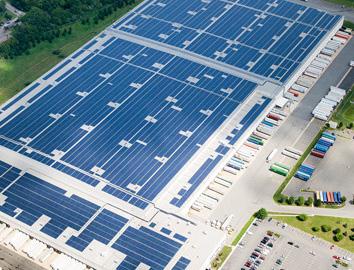
In 2002, BP Solar installed a photovoltaic facility on the roof of Terminal 2 of the Munich International Airport in Germany. This facility produces an average of approximately 500,000 kWh a year – equivalent to the electricity needs of around 200 households. The project used otherwise unused space and helps the airport offset its operational costs. High production of energy is guaranteed even in winter through the use of polycrystalline silicon cells and the optimal alignment of the solar modules at a 20 degree angle facing south. Germany is a global leader in PV generation because of projects like this. However, many airports and businesses across the United States and the globe have taken on similar projects.
U.S. companies take the opportunity for similar solar installations. On what was once a Toys “R” Us warehouse, Constellation Energy installed over 37,000 thin-film solar panels on the roof of the Flanders, New Jersey, distribution center. This rooftop installation has a generating capacity of 5.38 MW and can help the tenants of the facility offset over 60 percent of their annual electricity needs. Stadiums, businesses, warehouses, and airports are becoming prime locations for solar installations like these. Companies can help reduce their long-term operating costs while reducing their environmental impact.
Electricity makes our lives easier, but it can seem like a mysterious force. Measuring electricity is confusing because we cannot see it. We are familiar with terms such as watt, volt, and amp, but we do not have a clear understanding of these terms. We buy a 60-watt light bulb, a tool that requires 120 volts, or an appliance that uses 8.8 amps, but we do not think about what those units mean.
Using the flow of water as an analogy can make electricity easier to understand. The flow of electrons in a circuit is similar to water flowing through a hose. If you could look into a hose at a given point, you would see a certain amount of water passing that point each second. The amount of water depends on how much pressure is being applied—how hard the water is being pushed. It also depends on the diameter of the hose. The harder the pressure and the larger the diameter of the hose, the more water passes each second. The flow of electrons through a wire depends on the electrical pressure pushing the electrons and on the cross-sectional area of the wire.
The pressure that pushes electrons in a circuit is called voltage. Using the water analogy, if a tank of water were suspended one meter above the ground with a one-centimeter pipe coming out of the bottom, the water pressure would be similar to the force of a shower. If the same water tank were suspended 10 meters above the ground, the force of the water would be much greater, possibly enough to hurt you.
Voltage (V) is a measure of the pressure applied to electrons to make them move. It is a measure of the strength of the current in a circuit and is measured in volts (V). Just as the 10-meter tank applies greater pressure than the 1-meter tank, a 10-volt power supply (such as a battery) would apply greater pressure than a 1-volt power supply.
AA batteries are 1.5-volt; they apply a small amount of voltage for lighting small flashlight bulbs. A car usually has a 12-volt battery— it applies more voltage to push current through circuits to operate the radio or defroster. The standard voltage of wall outlets is 120 volts—a dangerous voltage. An electric clothes dryer is usually wired at 240 volts—a very dangerous voltage.
The flow of electrons can be compared to the flow of water. The water current is the number of molecules of water flowing past a fixed point; electric current is the number of electrons flowing past a fixed point. Electric current (I) is defined as electrons flowing between two points having a difference in voltage. Current is measured in amperes or amps (A). One ampere is 6.25 x 1018 electrons per second passing through a circuit.
With water, as the diameter of the pipe increases, so does the amount of water that can flow through it. With electricity, conducting wires take the place of the pipe. As the cross-sectional area of the wire increases, so does the amount of electric current (number of electrons) that can flow through it.
Resistance (R) is a property that slows the flow of electrons. Using the water analogy, resistance is anything that slows water flow, such as a smaller pipe or fins on the inside of a pipe.
In electrical terms, the resistance of a conducting wire depends on the properties of the metal used to make the wire and the wire’s diameter. Copper, aluminum, and silver—metals used in conducting wires—have different resistance.
Resistance is measured in units called ohms (Ω) . There are devices called resistors, with set resistances, that can be placed in circuits to reduce or control the current flow. Any device placed in a circuit to do work is called a load. The light bulb in a flashlight is a load. A television plugged into a wall outlet is also a load. Every load has resistance.



George Ohm, a German physicist, discovered that in many materials, especially metals, the current that flows through a material is proportional to the voltage. He found that if he doubled the voltage, the current also doubled. If he reduced the voltage by half, the current dropped by half. The resistance of the material remained the same.
This relationship is called Ohm’s Law and can be described using a simple formula. If you know any two of the measurements, you can calculate the third using the following formula:
voltage = current x resistance
V = I x R or V = A x Ω
Power (P) is a measure of the rate of doing work or the rate at which energy is converted. Electric power is the rate at which electricity is produced or consumed. Using the water analogy, electric power is the combination of the water pressure (voltage) and the rate of flow (current) that results in the ability to do work.
A large pipe carries more water (current) than a small pipe. Water at a height of 10 meters has much greater force (voltage) than at a height of one meter. The power of water flowing through a 1-centimeter pipe from a height of one meter is much less than water through a 10-centimeter pipe from 10 meters.
Electric power is defined as the amount of electric current flowing due to an applied voltage. It is the amount of electricity required to start or operate a load for one second. Electric power is measured in watts (W). The formula is:
power = voltage x current
P = V x I or W = V x A
Electrical energy introduces the concept of time to electric power. In the water analogy, it would be the amount of water falling through the pipe over a period of time, such as an hour. When we talk about using power over time, we are talking about using energy. Using our water example, we could look at how much work could be done by the water in the time that it takes for the tank to empty.
The electrical energy that an appliance or device consumes can be determined only if you know how long (time) it consumes electric power at a specific rate (power). To find the amount of energy consumed, you multiply the rate of energy consumption (measured in watts) by the amount of time (measured in hours) that it is being consumed. Electrical energy is measured in watt-hours (Wh).
energy = power x time
E = P x t or E = W x h = Wh
Another way to think about power and energy is with an analogy to traveling. If a person travels in a car at a rate of 40 miles per hour (mph), to find the total distance traveled, you would multiply the rate of travel by the amount of time you traveled at that rate.
If a car travels at 40 miles per hour for 1 hour, it would travel 40 miles.
distance = 40 mph x 1 hour = 40 miles
If a car travels at 40 miles per hour for 3 hours, it would travel 120 miles.
distance = 40 mph x 3 hours = 120 miles




The distance traveled represents the work done by the car. When we look at power, we are talking about the rate that electrical energy is being produced or consumed. Energy is analogous to the distance traveled or the work done by the car.
A person would not say he took a 40-mile per hour trip because that is the rate. The person would say he took a 40-mile trip or a 120-mile trip. We would describe the trip in terms of distance traveled, not rate traveled. The distance represents the amount of work done.
The same applies with electric power. You would not say you used 100 watts of light energy to read your book, because a watt represents the rate you use energy, not the total energy used. The amount of energy used would be calculated by multiplying the rate by the amount of time you read.
If you read for five hours with a 100-W light bulb, for example, you would use the formula as follows:
energy = power x time (E = P x t)
energy = 100 W x 5 hours = 500 Wh
One watt-hour is a very small amount of electrical energy. Usually, we measure electric power in larger units called kilowatt-hours (kWh) or 1,000 watt-hours (kilo = thousand). A kilowatt-hour is the unit that utilities use when billing most customers. The average cost of a kilowatt-hour of electricity for residential customers is about $0.129 or about 13 cents.
To calculate the cost of reading with a 100-W light bulb for five hours, you would change the watt-hours into kilowatt-hours, then multiply the kilowatt-hours used by the cost per kilowatt-hour, as shown below:
500 Wh / 1,000 = 0.5 kWh
0.5 kWh x $0.129/kWh = $0.065
Therefore, it would cost about seven cents to read for five hours with a 100-W light bulb.
1. Identify and explain the nuclear reaction in the sun that produces radiant energy.
2. Define renewable energy. Explain why solar energy is considered renewable.
3. Explain why a car parked in the sun becomes hot inside.
4. Why is a solar cell called a PV cell? What does the word photovoltaic mean? 5. Explain the conversion efficiency of a PV cell. How efficient are PV cells today?
6. How do new thin-film technologies compare to conventional PV cells?
7. Explain briefly how a PV cell converts radiant energy into electricity.
8. Do PV modules produce AC or DC current? Which type of current do most appliances use? What device converts DC to AC current?
9. Define the following electrical measures and the unit of measurement for each.
10. What is the average cost of a kilowatt-hour of electricity for U.S. residential customers?
Power (P) is a measure of the rate of doing work or the rate at which energy is converted. Electric power is defined as the amount of electric current flowing due to an applied voltage. Electric power is measured in watts (W). The formula is:
power = voltage x current
P = V x I or W = V x A
In series circuits, the current remains constant while the voltage changes. To calculate total voltage, add the individual voltages together:
Itotal = I1 = I2 = I3
Vtotal = V1 + V2 + V3
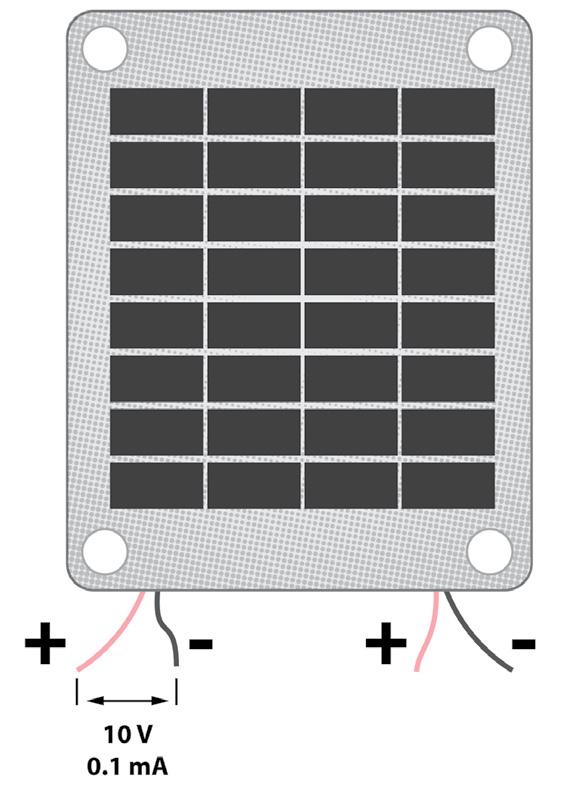
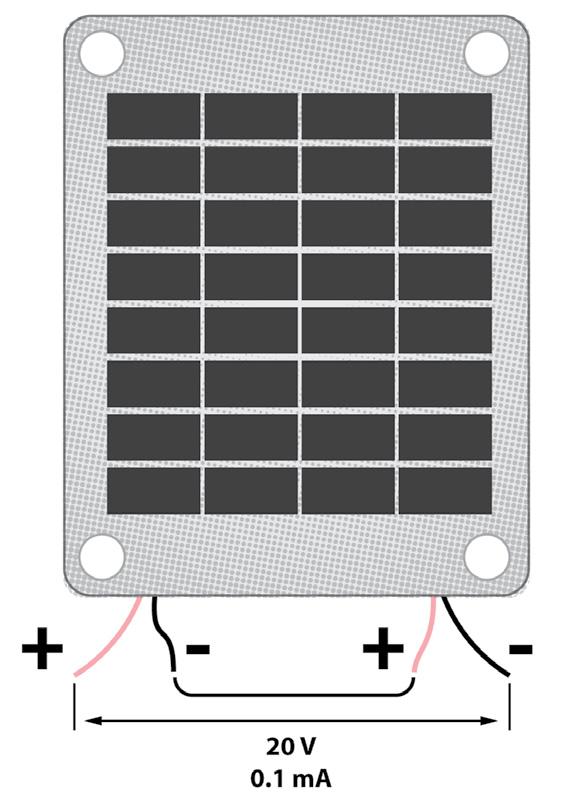
In parallel circuits, the voltage remains constant while the current changes. To calculate total current, add the individual currents together:
Itotal = I1 + I2 + I3
Vtotal = V1 = V2 = V3


1 Ampere = 1 coulomb/second
1 Coulomb = 6.24 x 1018 electrons (about a triple axle dump truck full of sand where one grain of sand is one electron)
Smaller (m)illi x 1/1000 or .001
(µ) micro x 1/1000000 or .000001 (n)ano x1/100000000 or .000000001 (p)ico x 1/1000000000000 or .000000000001
Bigger (K)ilo x 1,000 (M)ega x 1,000,000 (G)iga x 1,000,000,000
V = I x R
I = V/R
R = V/I
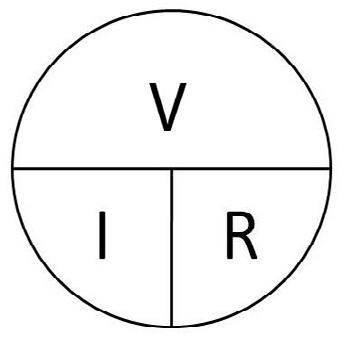
The formula pie works for any three variable equation. Put your finger on the variable you want to solve for and the operation you need is revealed.
Series Resistance (Resistance is additive)
RT= R1 + R2 + R3… +Rn
Parallel Resistance (Resistance is reciprocal)
1/RT= 1/R1 + 1/R2+ 1/R3… +1/Rn
Note: ALWAYS convert the values you are working with to the “BASE unit.” For example—don’t plug kilo-ohms (KΩ) into the equation—convert the value to Ω first.
ROTARY SWITCH
Directions DC Voltage ( )
1. Connect RED lead to VΩmA jack and BLACK to COM.
2. Set ROTARY SWITCH to highest setting on DC VOLTAGE scale (1000).
3. Connect leads to the device to be tested using the alligator clips provided.
4. Adjust ROTARY SWITCH to lower settings until a satisfactory reading is obtained.
5. With the solar modules or array, the 20 DCV setting usually provides the best reading.
DC Current ( )
1. Connect RED lead to VΩmA jack and BLACK to COM.
2. Set ROTARY SWITCH to 10 ADC setting.
3. Connect leads to the device to be tested using the alligator clips provided.
Note: The reading indicates DC AMPS; a reading of 0.25 amps equals 250 mA (milliamps).
4. With the solar modules or array, the 200mA DC setting usually provides the best reading.
The picture below is representative of the solar panels in the curriculum kit. Note that there are two modules in the panel, each with its own set of red (positive) and black (negative) wires. Designate one as Module 1 and the other as Module 2, and use this designation throughout your work with the panel.
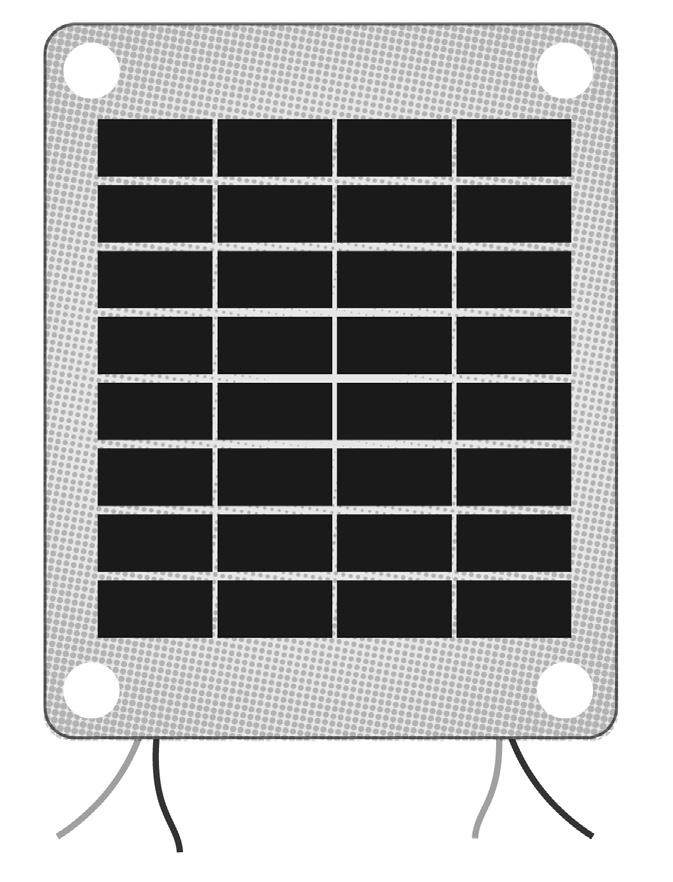
The digital multimeter used to measure current should be in series with the panel and the load. The digital multimeter used to measure voltage should be in parallel with the panel. Connect the panel, load, and current multimeter first, using alligator clips. The color of insulation on the alligator clip is irrelevant; we have used only red and black to help you distinguish how the circuit is connected.
When you connect the voltage multimeter to the circuit, clip the “jaws” of the alligator clip over the “jaws” of the other meter’s wire as shown.
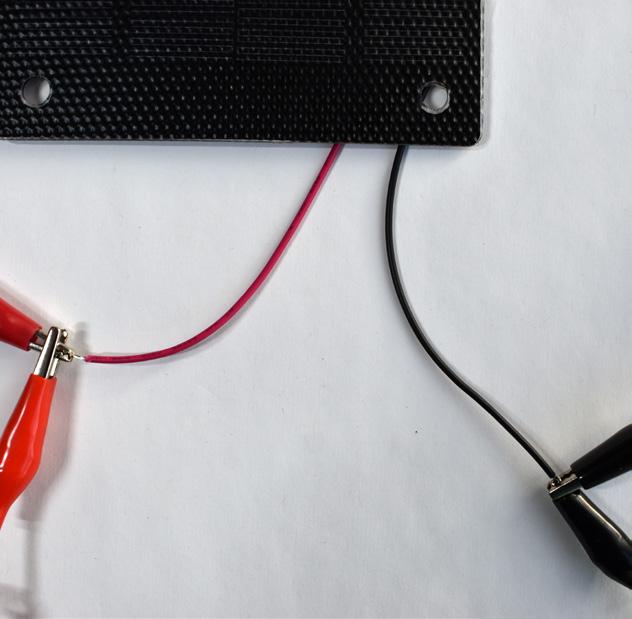

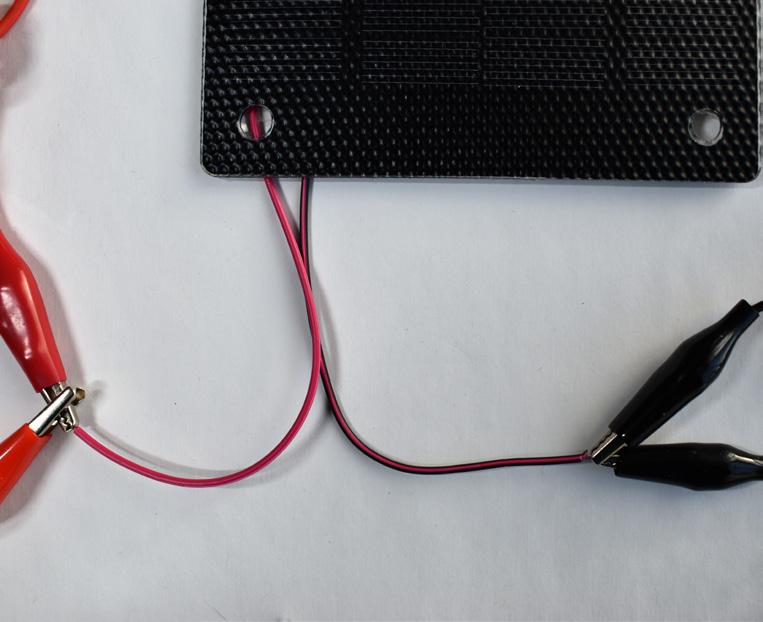

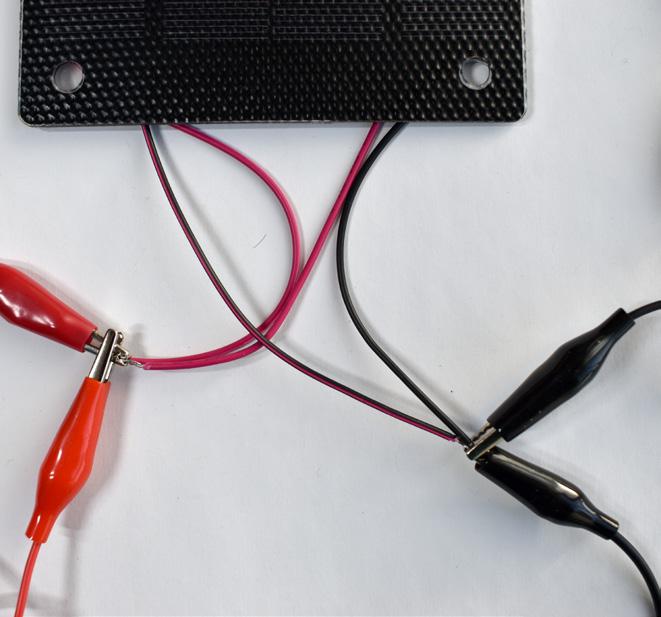
? Question
How do similar PV modules in an array vary in electrical output? Think about which varies more, current or voltage.
Hypothesis
Bright light source
Alligator clips
Electrical load (buzzer, motor/fan, or light )
Develop a hypothesis to address the question. Materials Procedure
PV array
2 Digital Multimeters
1. Test each PV module in the array by connecting the electrical load and meters as shown.
2. Use the multimeters to measure the current and voltage of each PV module in the array under identical external conditions.
3. Record the data below and compare.
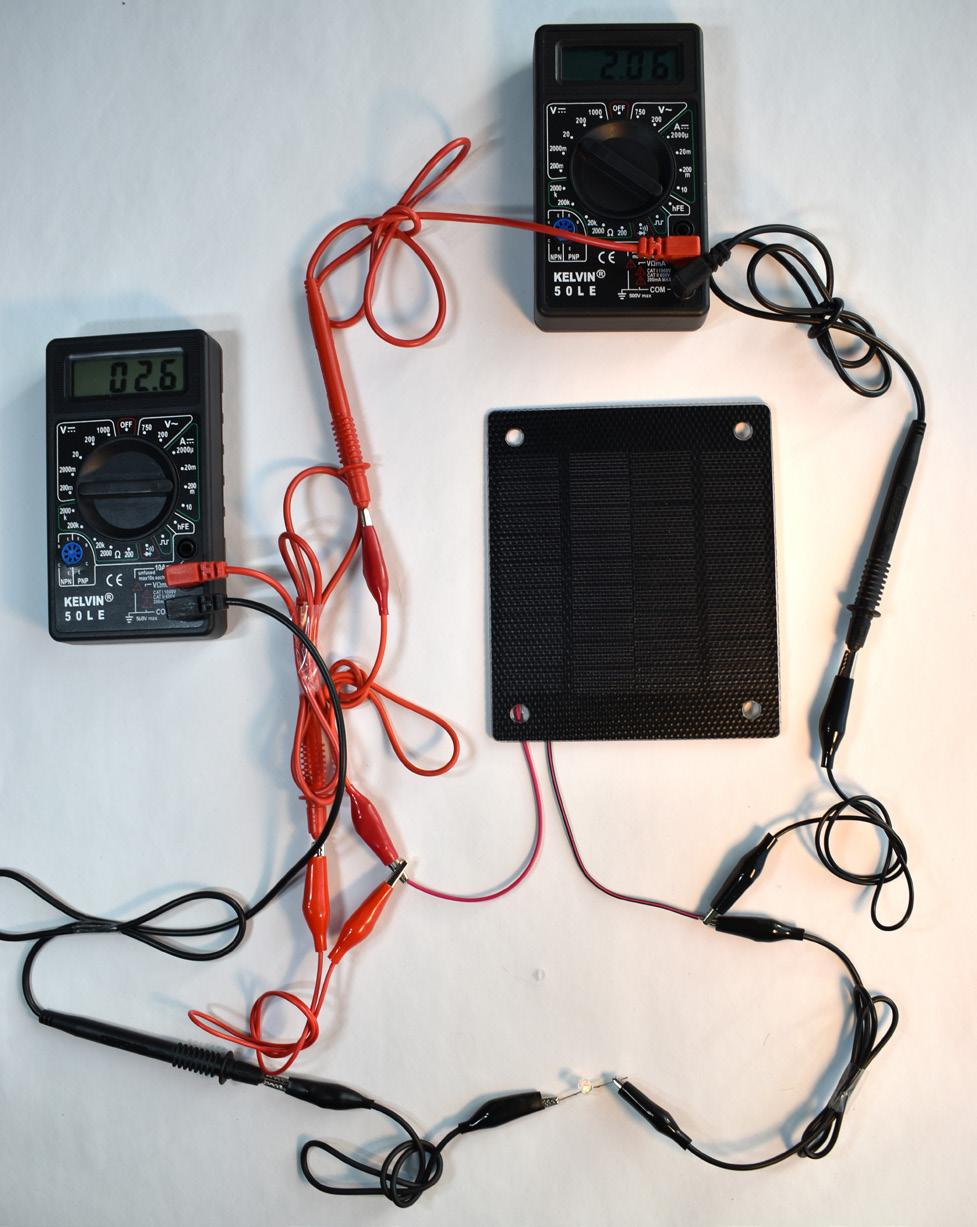
4. Calculate the power in Watts (current in Amps × voltage in Volts) of each module and record in the data table. Be mindful of the units on the multimeter and the data you collected!
Observations
Data
Conclusion Reflections
Were the output currents of the PV modules similar?
Were the output voltages of the PV modules similar?
How does a PV array wired in series affect the electrical output? Think about what will happen to current and voltage output.
Hypothesis
Develop a hypothesis to address the question.
Materials
Bright Light Source
Alligator Clips
Electrical load (buzzer, LED, etc.)
Procedure
PV array
2 Digital Multimeters
1. Connect the black wire of Module 1 to the red wire of Module If necessary, tape in place.
2. Connect the current multimeter and load in series with the solar panel.
3. Connect the voltage multimeter in parallel to the solar panel.
4. Turn on the light and hold it 5 cm from the panel.

5. Record the current and voltage produced by the panel, and calculate the power. Record all of these values in the data table.
Observations Data
Reflections
How did the current produced by both modules in series compare to the current produced by one module?
How did the voltage produced by both modules in series compare to the voltage produced by one module?
? Question
How does light intensity affect the electrical output of a PV array wired in series?
Hypothesis
Develop a hypothesis to address the question. Materials
Bright light source (high lumen output)
Moderately bright light source (medium lumen output)
Procedure
Dim light source (low lumen output)
Alligator clips
Electrical load (buzzer, LED, etc.)
PV array
2 Digital multimeters
1. Use the same series connection setup that you used in Solar 2
2. Using the dim light source, turn on the light and hold it 5 cm from the panel.
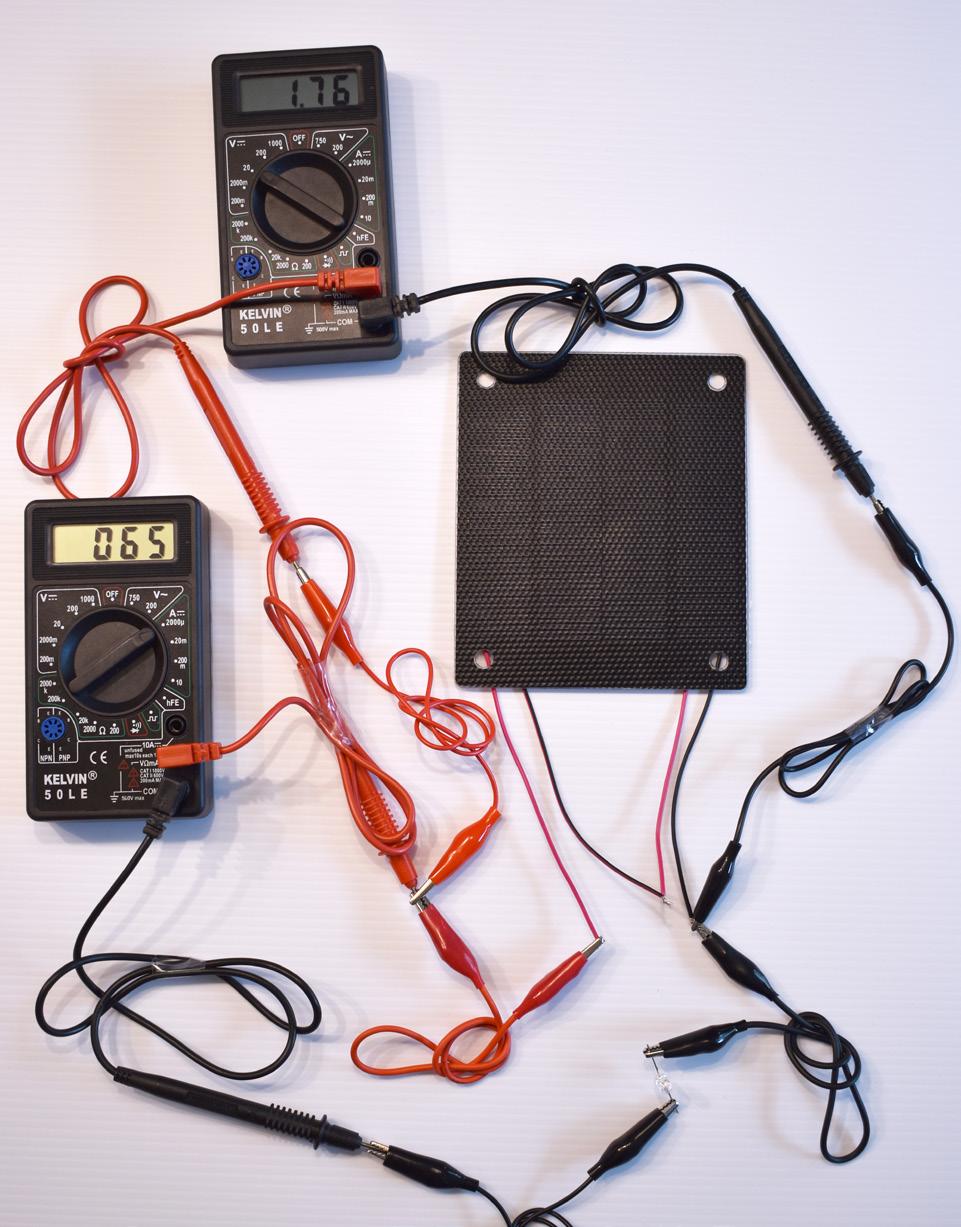
3. Measure the current and voltage, and calculate the power. Record all of these values in the data table.
4. Replace the dim light source with the moderately bright light source and repeat steps 2 and 3. Repeat again using the bright light source.
Observations
Data
Conclusion
Reflections
How did light intensity affect the electrical output of a PV array wired in series? Use the data you collected to support your answer.
Choose another light intensity that you did not use. For example, if your light sources were 500, 750, and 1,000 lumens, you could choose 600 lumens. Based on your data, what power output would you estimate the panel would produce with your chosen light intensity?
How does the angle of the light source relative to a PV panel affect the output of the panel?
Hypothesis
Develop a hypothesis to address the question.




Materials
Bright light source
Alligator clips
Electrical load (buzzer, LED, etc.)
Procedure
PV array
2 Digital multimeters
Protractor
1. Use the same series connection setup that you used in Solar 2
2. With the light source shining parallel to the lab table, the panel lying flat on the table and the lower edge of the panel 5 cm from the light source, measure the current and voltage output and record in the data table. This is 0°.
3. Using the protractor, tilt the panel 15° up and record the current and voltage.
4. Repeat step 3, each time tilting the panel up another 15°. Stop when the panel is 90°from the rays of light coming out of the light source (facing directly at the light).
5. Make a graph of power output of your panel vs. angle. Label the graph appropriately.
Observations
Conclusion
Reflections
How does angle of light incidence affect PV panel output? Use your data to support your statement. If the angle of light incidence was 22°, what do you predict the power output would be?
? Question
How does the distance from a light source affect the electrical output of a PV array wired in series?
Hypothesis
Develop a hypothesis to address the question.
Materials
Bright light source
Alligator clips
Electrical load (buzzer, LED, etc.)
Procedure
PV array 2 Digital multimeters
Meter stick
1. Use the same series connection setup that you used in Solar 2.

2. Starting with the light source 5 cm away, record the current and voltage output of the solar panel.
3. Increase the distance by 5 cm and record the current and voltage output of the solar panel.
4. Repeat step 3 for each additional 5 cm distance from the light source, stopping at 50 cm.
5. Calculate the power output for each distance.
6. Plot the power output you calculated vs each distance from the light source.
Observations
Conclusion
Reflections
What kind of mathematical function does the plot of your data resemble?
Using your data plot, predict the power output of your panel at a distance of 17 cm from the light source. If you can, test this result. Choose another two distances to predict and test.
Do you think it really matters if a PV sustem is ground-mounted or roof-mounted? Why or Why not?
How does covering different parts of the PV array wired in series affect its electrical output?
Hypothesis
Develop a hypothesis to address the question.
Materials
Bright light source
Alligator clips
Electrical load (buzzer, LED, etc.)
Procedure
PV array 2 Digital multimeters 3x5” piece of cardboard
1. Use the same series connected setup that you used in Solar 2.
2. Hold the light source 5 cm from the panel and measure the current and voltage. Record your data in the data table.
3. Using the cardboard, cover one half of the panel horizontally.
4. Hold the light source 5 cm from the panel and measure the current and voltage. Record your data in the data table.
5. Switch off the light and move the cardboard to cover one half of the panel vertically.
6. Hold the light source 5 cm from the panel and measure the current and voltage. Record your data in the data table.
Observations
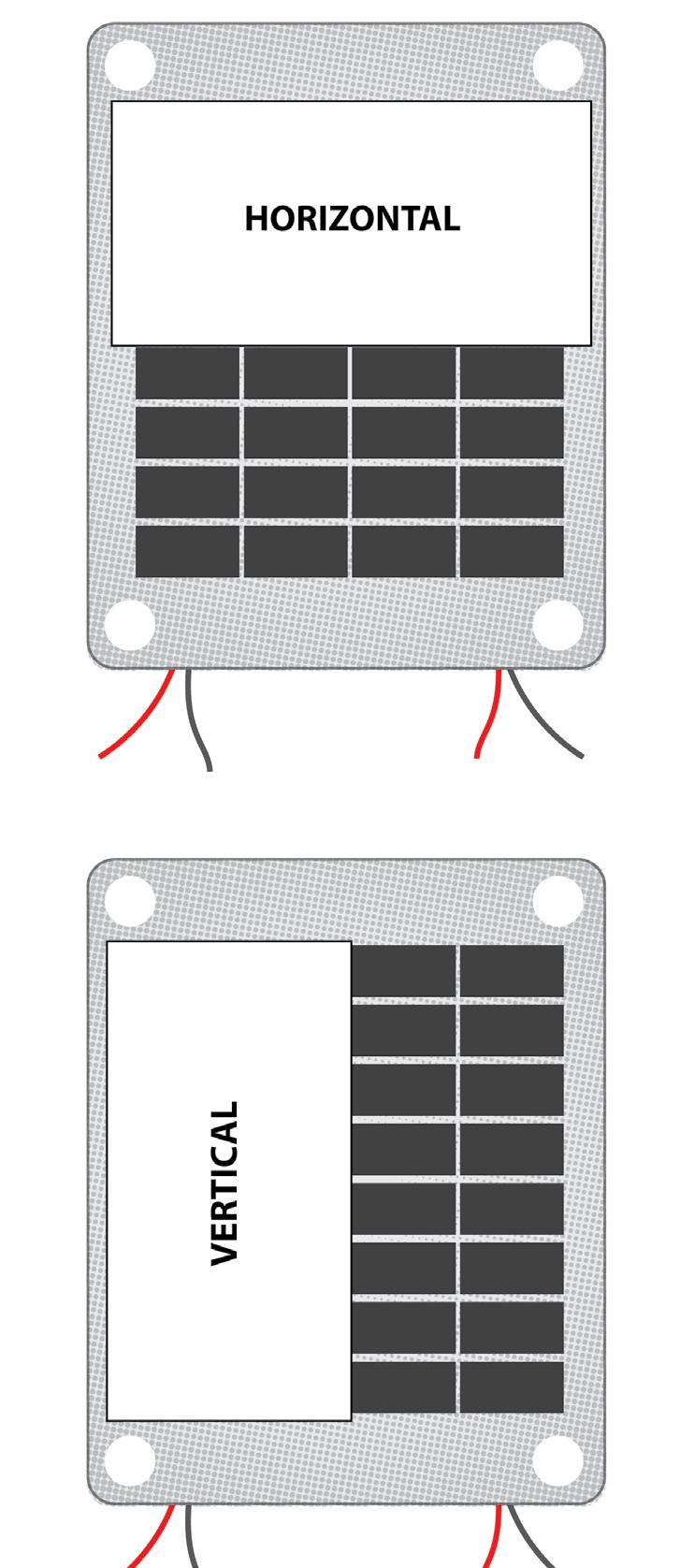
HORIZONTALLY COVERED
VERTICALLY COVERED
Conclusion
Reflections
How does your data relate to the installation site of a solar system? What must be taken into account? Based on what you have observed, how would placing the cardboard diagonally (corner-to-corner) over the panel affect the electrical output? Use data from your experiment to support your answer.
Study the panel carefully. Each module is a series of small solar cells connected to each other. How are they connected?
How does surface temperature affect the electrical output of a PV array wired in series?
Hypothesis
Develop a hypothesis to address the question.
Materials
Bright light source
Alligator clips
Electrical load (buzzer, LED, etc.)
Procedure
PV array
2 Digital multimeters
Ice water bath – a large, flat tub of ice water
1. Use the series connected setup you used in Solar 2
2. Use the thermometer to record the room temperature.
Watertight plastic bag
Hair dryer
Thermometer
3. Hold the bright light source 5 cm from the panel, turn it on, and record the current and voltage of the panel.
4. Carefully lift the solar panel from the table surface and slide the plastic bag over it.
5. Place the ice water bath on the table where the solar panel had been and put the bag-covered solar panel in the ice water bath. Do not allow any water to get on the wiring or multimeters! Leave it in place for 5 minutes.
6. Carefully remove the panel and bag from the ice water and remove the bag from the panel. Use paper towels to blot up any water, if any, that gets on the panel, the connections, or the table. Lay the panel back in its location on the table.
7. Quickly switch on the light source and hold it 5 cm above the panel and record the current and voltage.
8. Place the thermometer immediately alongside the panel on the table. Do not touch the panel with the thermometer but have it very close.
9. Switch on the hair dryer and warm the panel until it is 50° Celsius.
10. Quickly switch on the light source, hold it 5 cm above the panel, and record the current and voltage.
Observations
0° C (ICE BATH)
C (ROOM TEMPERATURE)
50° C
Conclusion
Reflections
How does temperature affect the output of a PV panel? Use the data you collected to support your answer. Is there anything about your findings that surprises you?
How do your findings reflect the way solar systems should be installed on a building? How do your findings reflect where solar systems can be installed geographically?
How does a PV array wired in parallel affect the electrical output? Think about what will happen to current and voltage in parallel as opposed to series.
Hypothesis
Develop a hypothesis to address the question.
Materials
Bright light source
Alligator clips
Electrical load (buzzer, LED, etc.)
PV array
2 Digital multimeters
Procedure
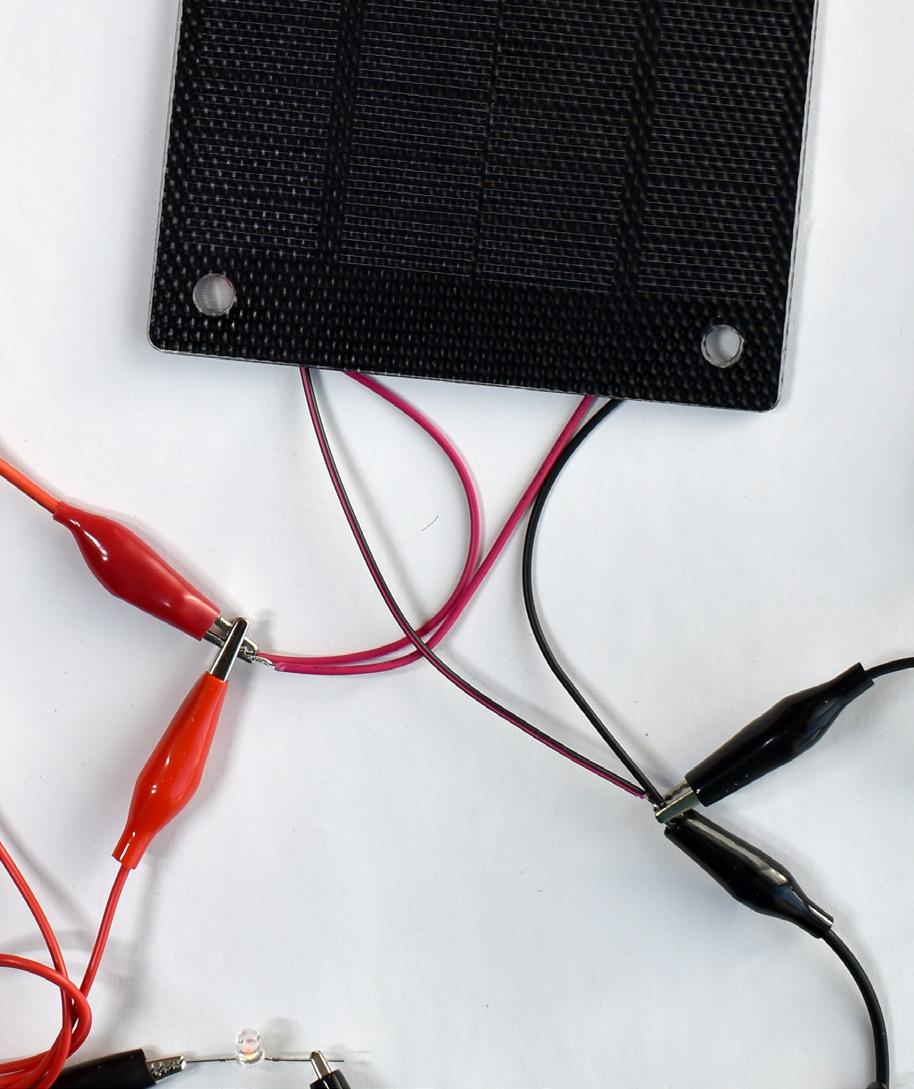
1. Hold both red wires for module 1 and module 2 together in one hand, and with the other hand attach an alligator clip to both wires. Attach the other end of the alligator clip to the red lead of the current multimeter.
2. Hold both black wires for module 1 and module 2 together in one hand, and with the other hand attach an alligator clip to both wires. Attach the other end of the alligator clip to the positive end of the load.
3. Attach a third alligator clip from the negative end of the load to the black lead of the current multimeter.
4. Clip the voltage multimeter red lead to the “jaws” of the alligator clip attached to both red wires. Repeat for the black, so the voltage multimeter is in parallel to the solar panel (see photograph).
5. Hold the light source 5 cm above the solar panel and switch it on.
6. Record the current and voltage of the circuit, and calculate the power output.
Observations
Conclusion
Reflections
How does a solar circuit wired in parallel compare to the same circuit wired in series? Use data from your activities to support your answer.
Carefully study the closeup photo of a solar panel. Each dark square is one solar cell, and the tiny lines on the top are conducting materials that connect to aluminum strips. After you have studied the panel sufficiently, explain how you think each solar cell is connected, and how the entire panel may be wired. Use the terms “series” and “parallel” in your description.
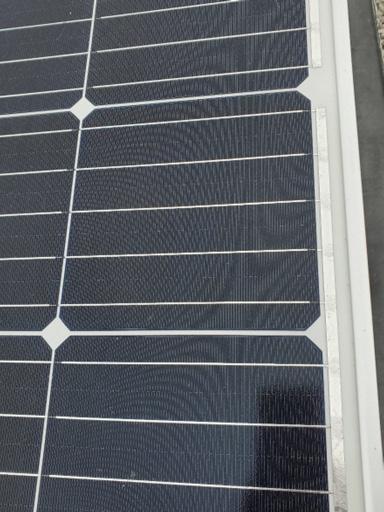
How does connecting multiple loads to a solar circuit wired in series affect electrical output?
Hypothesis
Develop a hypothesis to address the question.
Materials
Bright light source
Alligator clips
2 or more electrical loads (buzzer, LED, etc.)
Procedure
PV array
2 Digital multimeters
1. Connect your solar circuit in series as you did for Solar 2, inserting one additional load in series with the other.
2. Hold the light 5 cm above the solar panel and switch it on.
3. Record the voltage and current of the circuit, and calculate the power.
Observations
Data
Conclusion Reflections
? Question
How does connecting multiple loads to a solar circuit wired in parallel affect electrical output?
Hypothesis
Develop a hypothesis to address the question.
Materials
Bright light source
Alligator clips
2 or more electrical loads (buzzer, LED, etc.)
Procedure
PV array
2 Digital multimeters
1. Connect your solar circuit in series as you did for Solar 8, inserting one additional load in series with the other.
2. Hold the light 5 cm above the solar panel and switch it on.
3. Record the voltage and current of the circuit, and calculate the power.
Observations
Data
Conclusion Reflections
How does connecting multiple solar panels in series or parallel affect electrical output?
Hypothesis
Develop a hypothesis to address the question.
Materials
Bright light source
Alligator clips
Electrical load (buzzer, LED, etc.)
Digital multimeters
1. As a group, decide how you will connect your solar panels. Will you connect everything in series? In parallel? Or some combination? Once you have all agreed, make a diagram of your connection in the Observations section.
2. Connect a load and one multimeter in series with your solar panels.
3. Add a second multimeter in parallel across the solar panels, so it is measuring both of them at once.
4. Hold the light source 5 cm above the solar panels and switch it on.
5. Record the current and voltage, and calculate the power.
6. If you have time, configure your solar panel connection a different way and repeat. Data
Did the solar panels produce power in the way you had predicted? Explain your answer using data from the activity. What factors do you think contributed to the differences you observed?
How does this activity mimic the way commercially-sized solar panels are connected?
If you were recommending the way commercially-sized solar panes should be wired together, what would you suggest? Support your answer with evidence gathered throughout this solar unit.
Below are twelve 12-volt photovoltaic modules rated at 80 watts each.
Design an array to deliver 48 volts to the inverter by using a combination of series and parallel circuits.
Use dashed lines to represent the black (-) wires, and solid lines to represent the red (+) wires.
Write an algebraic equation representing the 48-volt circuit you created.
Is there more than one design that could have created the 48-volt circuit?
Part One: How much energy do you need per day?
1. How much electricity does your family consume each month (in kilowatt hours, kWh)? _____________ kWh
2. What is your daily electricity use in kWh? _____________ kWh
3. What is your daily electricity use in watt-hours? _____________ watt-hours
Part Two: How much energy can a module produce on an average day where YOU live?
1. Peak sun hours are the number of hours per day where solar insolation equals 1,000 watts/square meter. Use the U.S. Solar Resource Map to determine how many peak sun hours your home city receives each day. peak sun hours
2. How much energy will one 250-watt solar module generate on the average day? 250 watts x _______ peak sun hours = ________watt-hours daily production per module
Part Three: How big does your system need to be for where you live?
1. How many 250-watt solar modules would you need to produce enough electricity for your home?
Answer: _______modules
2. If each module costs $775.00 installed, how much would it cost for the number of solar modules you need? Answer: $______________
Part Four: How many years will it take before the system has paid for itself?
1. Calculate your current cost for electricity (multiply your monthly total kWh use by the rate in your city/town).
2. A) How much do you pay each month? $___________ B) How much do you pay each year? $_____________
3. The payback period is the time it will take for your system price to be offset by the electrical energy bills that will be avoided. Divide the total system cost (Part 3, Step 2) by your annual cost for electricity (Part 4, Step 2B).
Answer:_______________ years
Part Five: Reflect
1. What are the different factors that impact payback period?
2. Under what circumstances is it NOT worth installing a solar generating system?
3. Think about when you use the most electricity. Do these hours coincide with peak sun hours? What would you need in order to use solar energy around the clock?
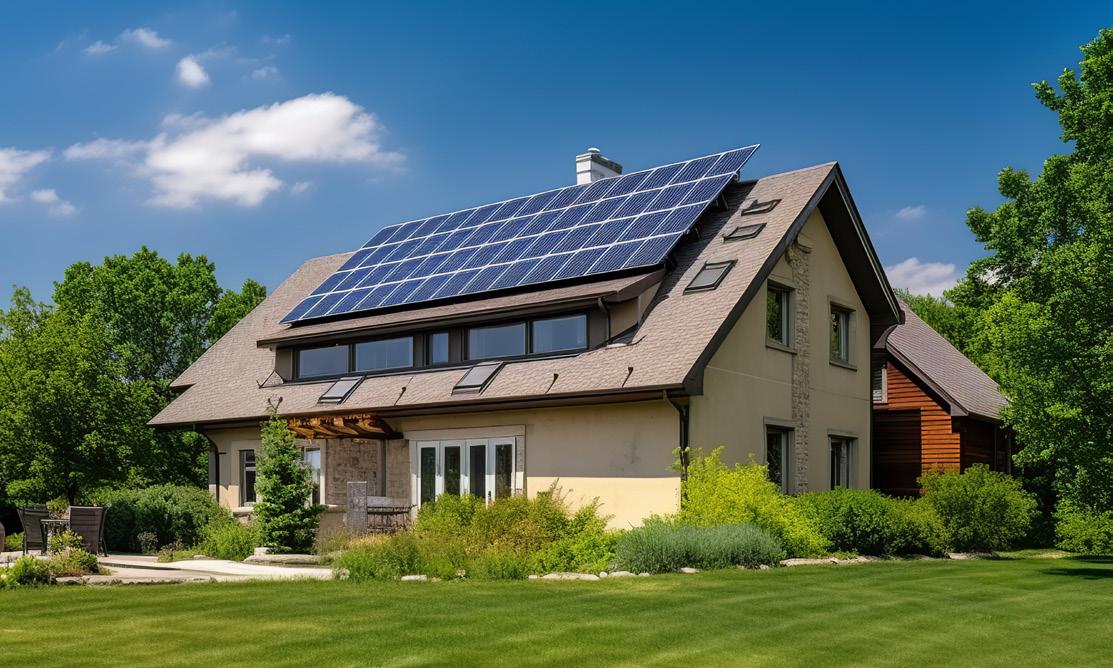
Your crazy old Uncle Ed has just willed you a cabin that he has on a river near Page, AZ. The only problem is that the cabin has no electricity. Uncle Ed believes in hard work and he’s specified one condition—if you are to take possession of this prime parcel, you must plan and install a PV system to support the following four specifications:
a light for the kitchen (LED, 12 volts at 15 watts);
a power supply for charging your laptop (12 volts at 90 watts);
an electric pump for the well (12 volts at 100 watts intermittent); and
a refrigerator (12 volts at 50 watts intermittent).
Before you can collect your inheritance, Uncle Ed’s lawyer will need to see:
a description of the PV modules that you will use along with their ratings;
a schematic diagram of your system design; and
a spreadsheet detailing your budget and sources for parts.
Have fun!
Extension
When you finish your plan, design a battery system to store the electrical energy generated for use at night or during storms.

Description of Modules:
Diagram of Design:
Budget Information:









albedo the amount of solar energy reflected back from the Earth’s surface; different surfaces have different levels of reflectivity
alternating current (AC) an electric current that reverses its direction at regular intervals or cycles; in the U.S. the standard is 120 reversals or 60 cycles per second; typically abbreviated as AC amorphous lacking shape or form
ampere (A) a unit of measure for an electric current; the amount of current that flows in a circuit at an electromotive force of one volt and at a resistance of one ohm; abbreviated as amp
array a systematic arrangement, in rows, of photovoltaic cells
baseload power the minimum amount of electricity a utility must have available to its customers, at all times charge controller a device that controls or limits how much electric current is added to or removed from a storage device or battery
concentrated solar power technologies that focus the energy from the sun onto one smaller area creating high temperatures that can produce electricity
conversion efficiency a ratio of useful energy output compared to the energy input Czochralski process a method of growing crystals for semiconductors
direct current (DC) an electric current that flows in only one direction through a circuit, as from a battery; typically abbreviated as DC
dopant an element that is inserted into a substance to alter the conductivity or electrical properties energy efficiency the ratio of useful energy delivered compared to energy supplied electric current (I) the flow of charged particles like electrons through a circuit, usually measured in amperes electric power the rate at which energy is transferred; electrical energy is usually measured in watts; also used for a measurement of capacity
gamma rays energy in the form of high-energy, short wavelength, electromagnetic radiation released by the nucleus; gamma rays are similar to x-rays and are best stopped or shielded by dense materials, such as lead grid the layout of an electrical distribution system
heliostat a sun-tracking or seeking mirror ingot a material (usually metal) cast into a shape; semiconductors in bulk cast by a mold inverter device that converts direct current to alternating current kilowatt-hour (kWh) a measure of electricity as a unit of work or energy, measured as 1 kilowatt of power expended for 1 hour Law of Conservation of Energy the law governing energy transformations and thermodynamics; energy may not be created or destroyed, it simply changes form, and thus the sum of all energies in the system remains constant module multiple PV cells connected together in larger units
n-type silicon layer of silicon in a solar cell that has been doped with phosphorus to have a negative character and repel electrons
nuclear fusion when the nuclei of atoms are combined or “fused” together; the sun combines the nuclei of hydrogen atoms into helium atoms in a process called fusion; energy from the nuclei of atoms, called “nuclear energy”, is released from fusion
ohm (Ω) the unit of resistance to the flow of an electric current
Ohm’s Law a mathematical relationship between voltage (V), current (I), and resistance (R) in a circuit; Ohm’s Law states the voltage across a load is equal to the current flowing through the load times the resistance of the load (V = I x R)
p-type silicon layer of silicon in a solar cell that has been doped with boron to have a positive character and attract electrons
peak load power amount of power needed to supply consumers during times of high demand photons particles that transmit light photosphere the outer layer of the sun or a star; light is radiated from the photosphere photovoltaic cell a device, usually made from silicon, which converts some of the energy from light (radiant energy) into electrical energy; another name for a solar cell photovoltaic effect creating electric current through exposure of a material to light; excited electrons become free, eventually being converted into electrical energy photovoltaic system an arrangement of components to supply power from the sun, often including the PV module(s), storage component, inverter, and connections power (P) the rate at which energy is transferred, measured in watts radiant energy any form of energy radiating from a source in electromagnetic waves renewable fuels that can be easily made or replenished; we can never use up renewable fuels resistance (R) a measure of the amount of energy per charge needed to move a charge through an electric circuit, usually measured in ohms
secondary source of energy also known as energy carriers, these sources require another source of energy to be created;electricity is an example of a secondary source of energy semiconductor any material that has a limited capacity for conducting an electric current; semiconductors are crystalline solids, such as silicon, that have an electrical conductivity between that of a conductor and an insulator
solar collector an item, like a car or greenhouse, that absorbs radiant energy from the sun and traps it within thermal energy the total potential and kinetic energy associated with the random motions of the atoms and molecules of a material; the more the molecules move and vibrate the more energy they possess transmutation a process involving a change in the number of protons or neutrons in the nucleus, resulting in the formation of a different isotope; this occurs during alpha and beta emissions
volt (V) measure of electric potential or electromotive force; a potential of one volt appears across a resistance of one ohm when a current of one ampere flows through that resistance voltage the difference in electrical potential between any two conductors or between a conductor and the ground; it is a measure of the electrical energy per electron that electrons can acquire and/or give up as they move between the two conductors
watt (W) a metric unit of power, usually used in electric measurements, which gives the rate at which work is done or energy is used
Looking for some fun energy activities? There are plenty of fun games, puzzles, and activities available at www.NEED.org



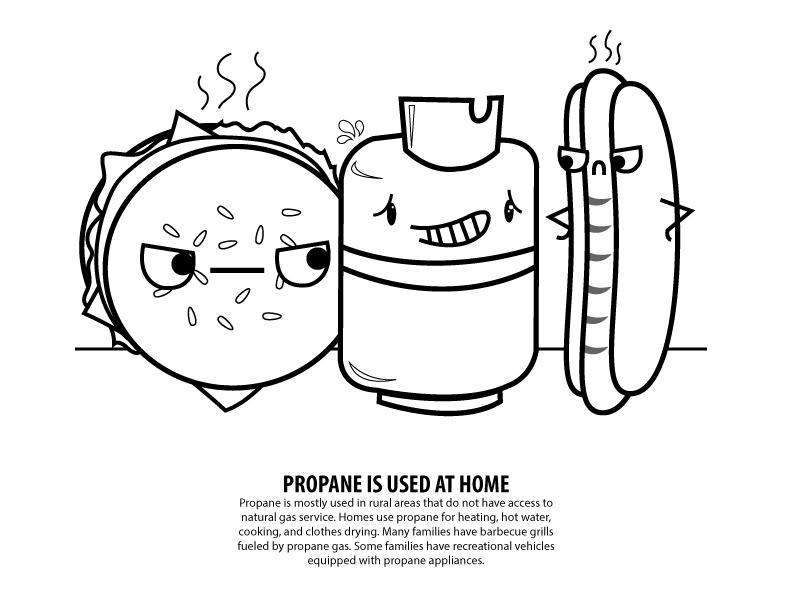
Windissimplyairinmotion.ItiscausedbytheunevenheatingoftheEarth’ssurfacebyradiantenergy fromthesun.SincetheEarth’ssurfaceismadeofverydifferenttypesoflandandwater,itabsorbsthesun’s energyatdifferentrates.Theheavier,denser,coolairoverthewaterflowsintotakeitsplace,creatingwind. Inthesameway,theatmosphericwindsthatcircletheEartharecreatedbecausethelandneartheEquator isheatedmorebythesunthanlandneartheNorthandSouthPoles.
Biomassisanyorganicmatterthatcanbeusedasanenergysource.Wood,crops,andyardandanimal wasteareexamplesofbiomass.Peoplehaveusedbiomasslongerthananyotherenergysource. Forthousandsofyears,peoplehaveburnedwoodtoheattheirhomesandcooktheirfood.
Foldinalongdottedlines, crease,andunfold
Foldinalongdottedlines, crease,andunfold

Foldinalongdottedlines, crease,andunfold
UnfoldStep4on thetophalf
Foldinalongdottedlines, tomeetthecenter
Foldinalongdottedlines, tomeetthecenter
Foldinalongdottedlines, crease,andunfold
Open,Bringthetopdown andpresspaperflat
Foldinthecreases
Foldforwardalongthedotted linesandcrease Repeatonothersides
Openthepocketandflatten
Repeatonallfoursides

Folddownalongdottedlines Repeatonallfoursides
Makethe2diagonalfoldsasindicatedand

http://need-media.smugmug.com/
On NEED’s SmugMug page, you’ll find pictures of NEED students learning and teaching about energy. Would you like to submit images or videos to NEED’s gallery? E-mail info@NEED.org for more information.
Also use SmugMug to find these visual resources:
Videos
Need a refresher on how to use Science of Energy with your students? Watch the Science of Energy videos. Also check out our Energy Chants videos! Find videos produced by NEED students teaching their peers and community members about energy.
Online Graphics Library
Would you like to use NEED’s graphics in your own classroom presentations, or allow students to use them in their presentations? Download graphics for easy use in your classroom.
Looking for more resources? Our Awesome Extras page contains PowerPoints, animations, and other great resources to compliment what you are teaching in your classroom! This page is available under the Educators tab at www.NEED.org.
Building an assessment? Searching for standards? Check out our Evaluations page for a question bank, NEED’s Energy Polls, sample rubrics, links to standards alignment, and more at www.NEED.org/.
The NEED Project offers e-publication versions of various guides for in-classroom use. Guides that are currently available as an e-publication can be found at www.issuu.com/theneedproject.





Stay up-to-date with NEED. “Like” us on Facebook! Search for The NEED Project, and check out all we’ve got going on!
Follow us on Twitter. We share the latest energy news from around the country, @NEED_Project.
Follow us on Instagram and check out the photos taken at NEED events, instagram.com/theneedproject.
Follow us on Pinterest and pin ideas to use in your classroom, Pinterest.com/NeedProject.
Subscribe to our YouTube channel! www.youtube.com/user/NEEDproject
Looking for cross-curricular connections, or extra background reading for your students? NEED’s booklist provides an extensive list of fiction and nonfiction titles for all grade levels to support energy units in the science, social studies, or language arts setting. Check it out at www.NEED.org/.
Maps are a great way for students to visualize the energy picture in the United States. This set of maps will support your energy discussion and multi-disciplinary energy activities. Go to www.need.org/energyinsocietymaterials to see energy production, consumption, and reserves all over the country!





AES
AES Clean Energy Development
American Electric Power Foundation
Appalachian Voices
Arizona Sustainability Alliance
Atlantic City Electric
Baltimore Gas & Electric
Berkshire Gas - Avangrid
BP America Inc.
Bob Moran Charitable Giving Fund
Cape Light Compact–Massachusetts
Celanese Foundation
Central Alabama Electric Cooperative CITGO
The City of Cuyahoga Falls
Clean Virginia CLEAResult
ComEd
Con uence
ConocoPhillips
Constellation
Delmarva Power and Light
Department of Education and Early Childhood
Development - Government of New Brunswick, Canada
Dominion Energy, Inc.
Dominion Energy Charitable Foundation
DonorsChoose
East Baton Rouge Parish Schools
East Kentucky Power Cooperative
EcoCentricNow
EDP Renewables
EduCon Educational Consulting
Enel Green Power North America
ENGIE
Entergy
Equinix
Eversource
Exelon
Exelon Foundation
Foundation for Environmental Education
FPL
Generac
Georgia Power
Gerald Harrington, Geologist
Government of Thailand–Energy Ministry
Greater New Orleans STEM
GREEN Charter Schools
Green Power EMC
Guilford County Schools–North Carolina
Honeywell
Iowa Governor’s STEM Advisory Council -
Scale Up
Iowa Lakes Community College
Iowa State University
Illinois Clean Energy Community Foundation
Illinois International Brotherhood of Electrical
Workers Renewable Energy Fund
Independent Petroleum Association of New Mexico
Intuit
Iron Mountain Data Centers
Kansas Corporation Energy Commission
Kansas Energy Program – K-State Engineering Extension
Katy Independent School District
Kentucky Environmental Education Council
Kentucky O ce of Energy Policy
Kentucky Power–An AEP Company
Liberty Utilities
Llano Land and Exploration
Louisiana State Energy O ce
Louisiana State University – Agricultural Center
LUMA
Marshall University
Mercedes Benz USA
Minneapolis Public Schools
Mississippi Development Authority–Energy Division
Motus Experiential
National Fuel
National Grid
National Hydropower Association
National Ocean Industries Association
National Renewable Energy Laboratory
NC Green Power
Nebraskans for Solar
NextEra Energy Resources
Nicor Gas
NCi – Northeast Construction
North Shore Gas
O shore Technology Conference
Ohio Energy Project
Oklahoma Gas and Electric Energy Corporation
Omaha Public Power District
Ormat
Paci c Gas and Electric Company
PECO
Peoples Gas
Pepco
Performance Services, Inc.
Permian Basin Petroleum Museum
Phillips 66
PowerSouth Energy Cooperative
PPG
Prince George’s County O ce of Human Resource Management (MD)
Prince George’s County O ce of Sustainable Energy (MD)
Providence Public Schools
Public Service of Oklahoma - AEP
Quarto Publishing Group
The Rapha Foundation
Renewable Energy Alaska Project
Rhoades Energy
Rhode Island O ce of Energy Resources
Salal Foundation/Salal Credit Union
Salt River Project
Salt River Rural Electric Cooperative
Schneider Electric
C.T. Seaver Trust
Secure Solar Futures, LLC
Shell USA, Inc.
SMUD
Society of Petroleum Engineers
South Carolina Energy O ce
Southern Company Gas
Snohomish County PUD
SunTribe Solar
TXU Energy
United Way of Greater Philadelphia and Southern New Jersey
Unitil
University of Iowa
University of Louisville
University of North Carolina
University of Northern Iowa
University of Rhode Island
U.S. Department of Energy
U.S. Department of Energy–O ce of Energy
E ciency and Renewable Energy
U.S. Department of Energy - Solar Decathlon
U.S. Department of Energy - Water Power
Technologies O ce
U.S. Department of Energy–Wind for Schools
U.S. Energy Information Administration
United States Virgin Islands Energy O ce
Virginia Cooperative Extension
Vistra Energy
We Care Solar
West Virginia O ce of Energy
West Warwick Public Schools